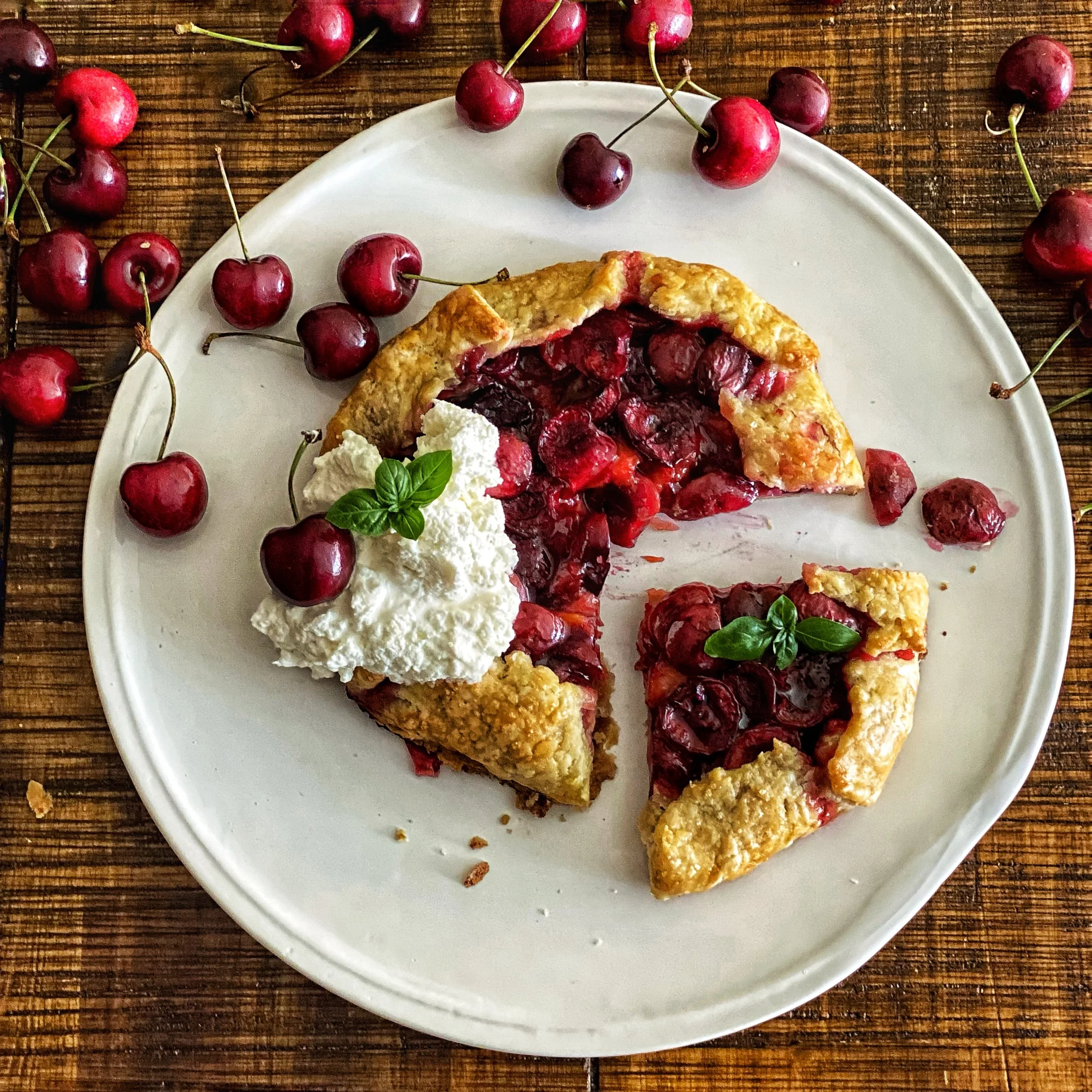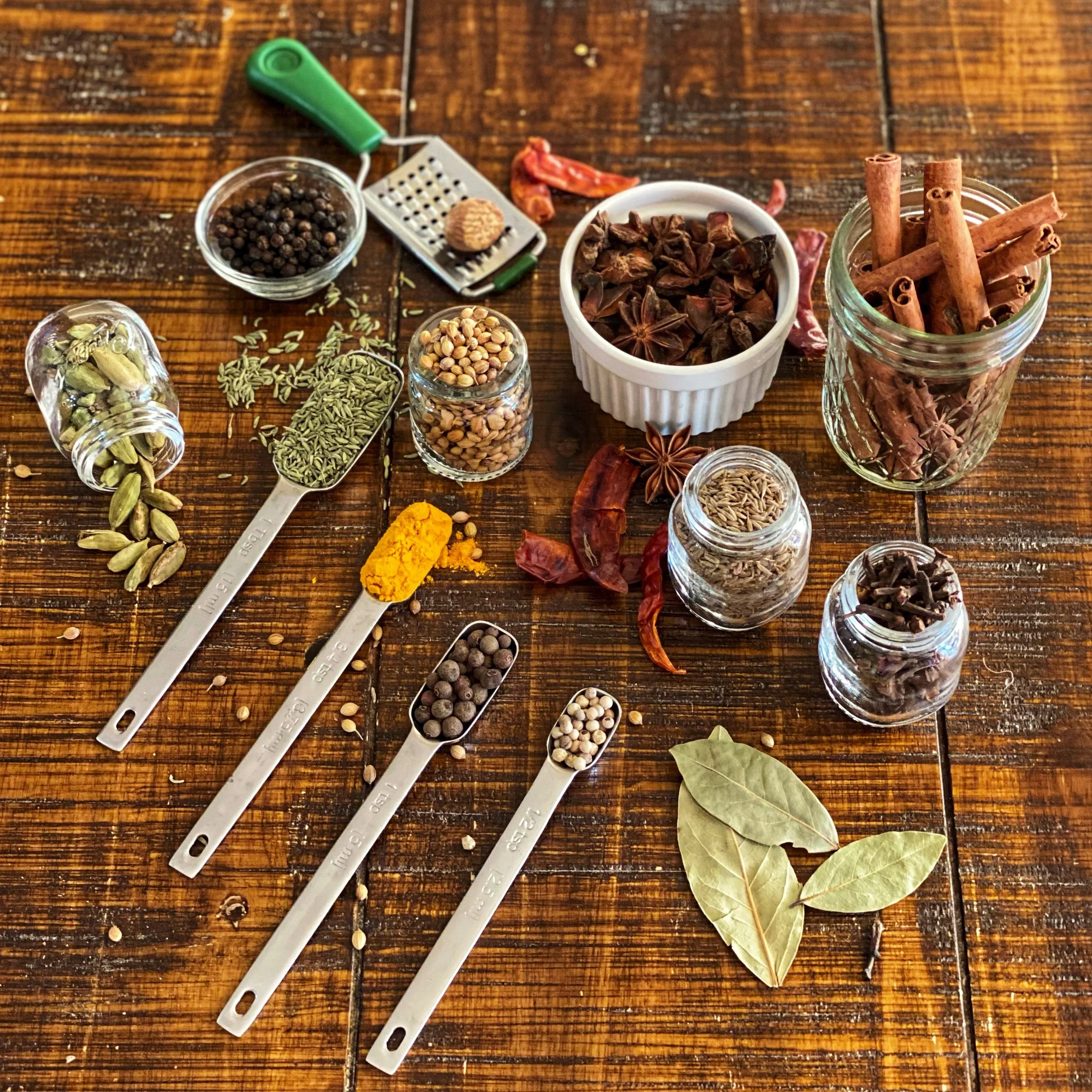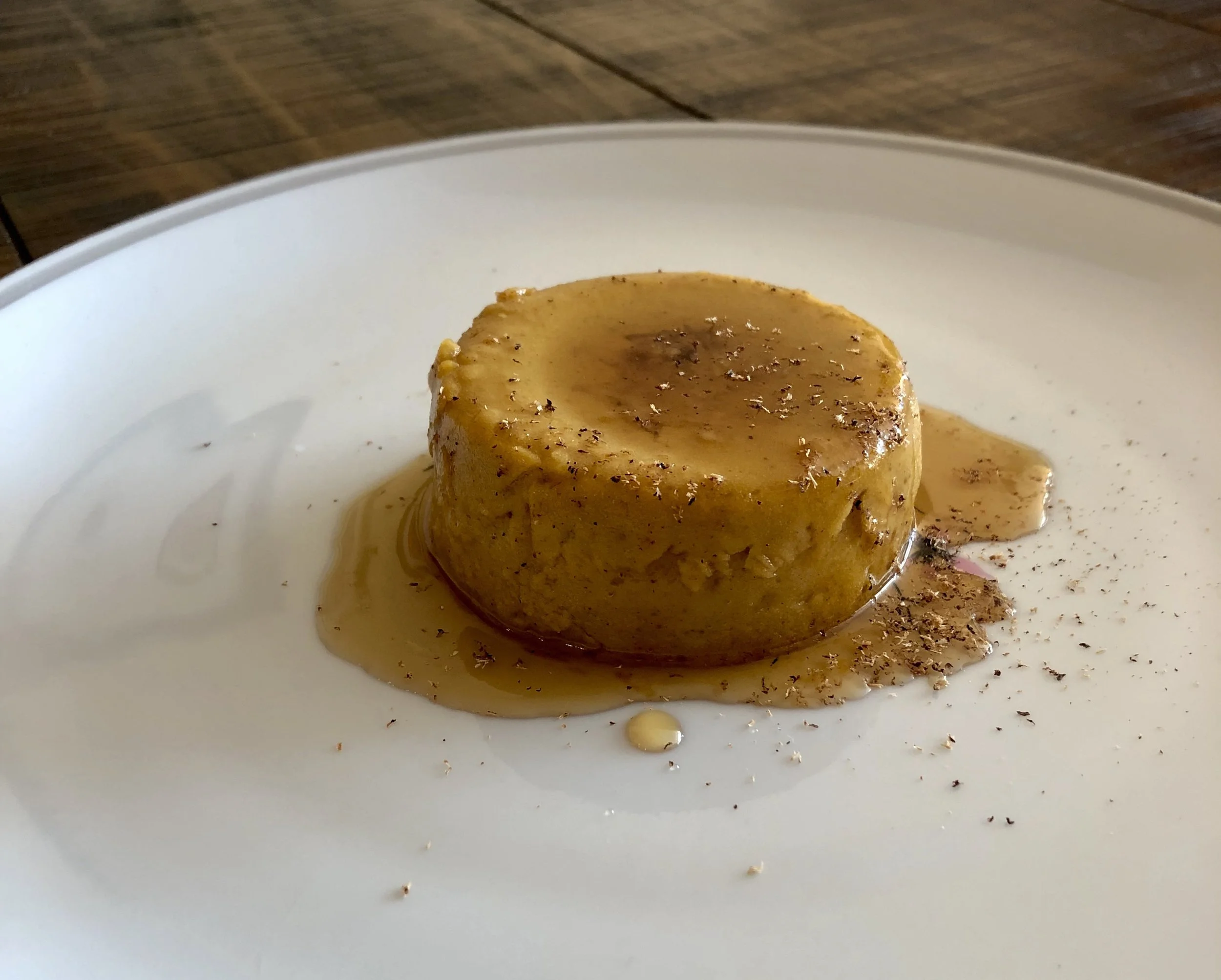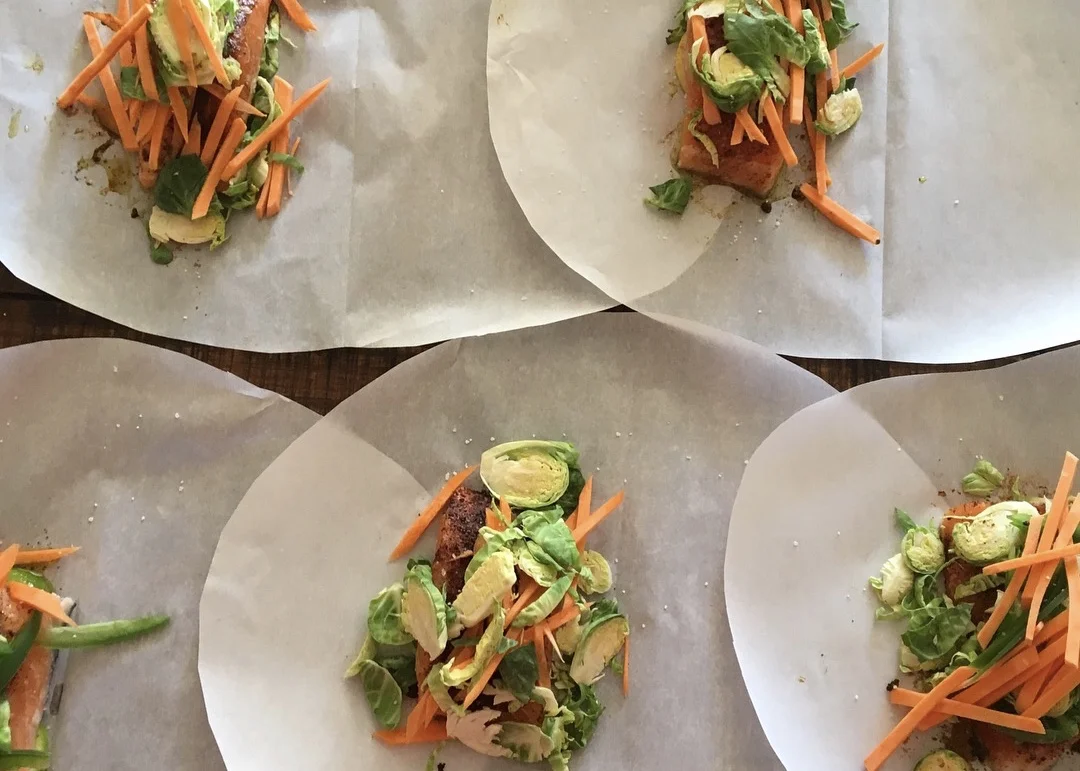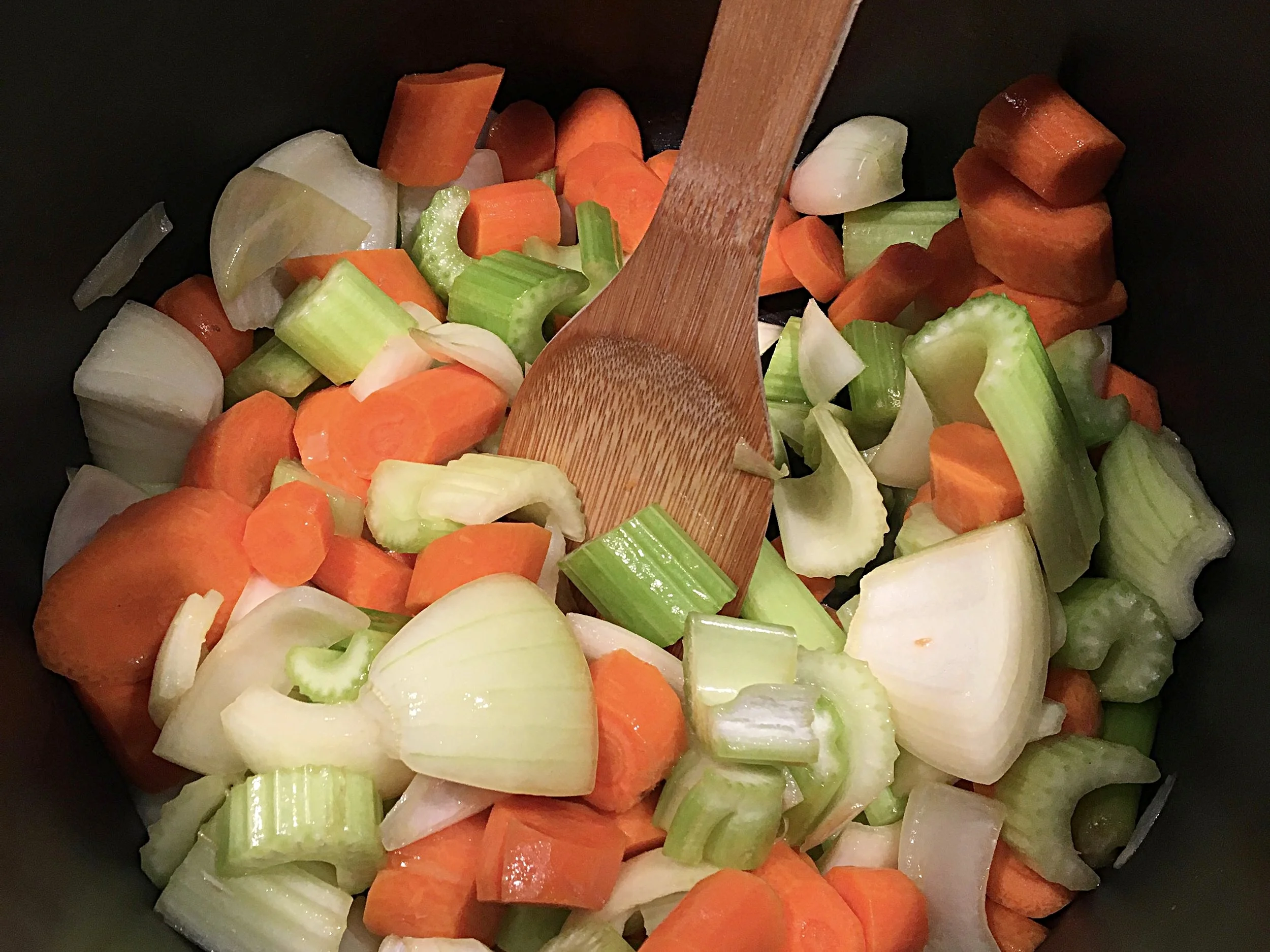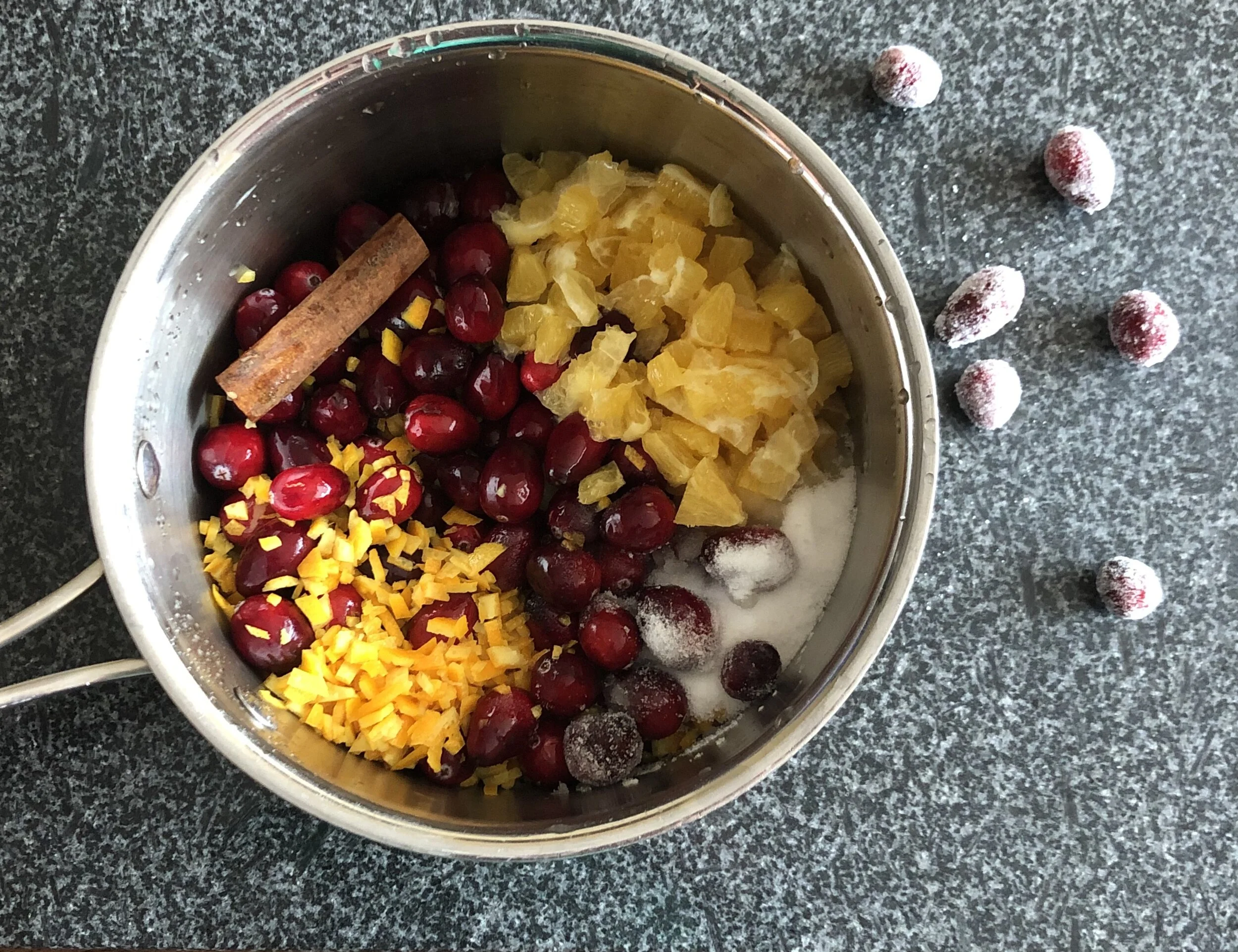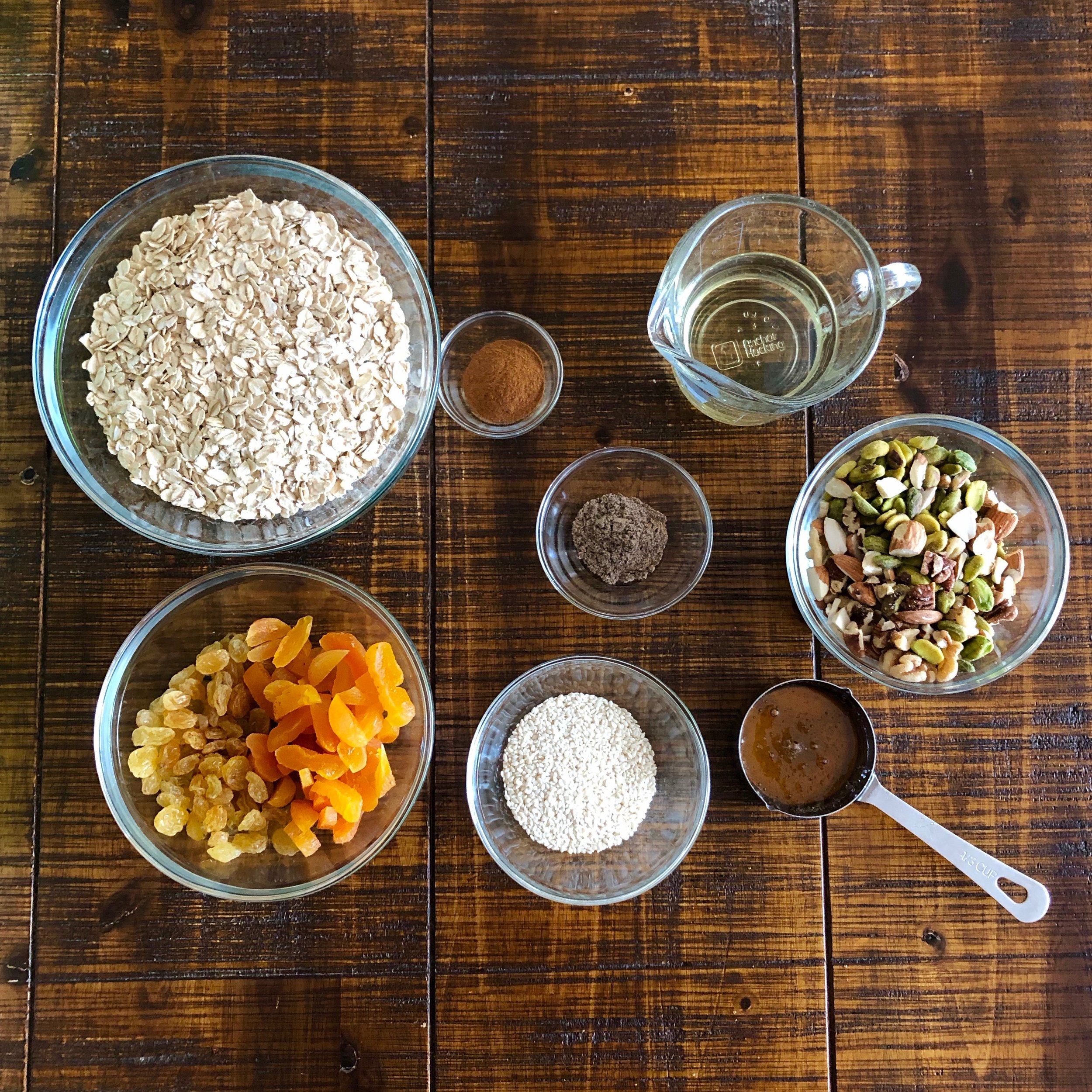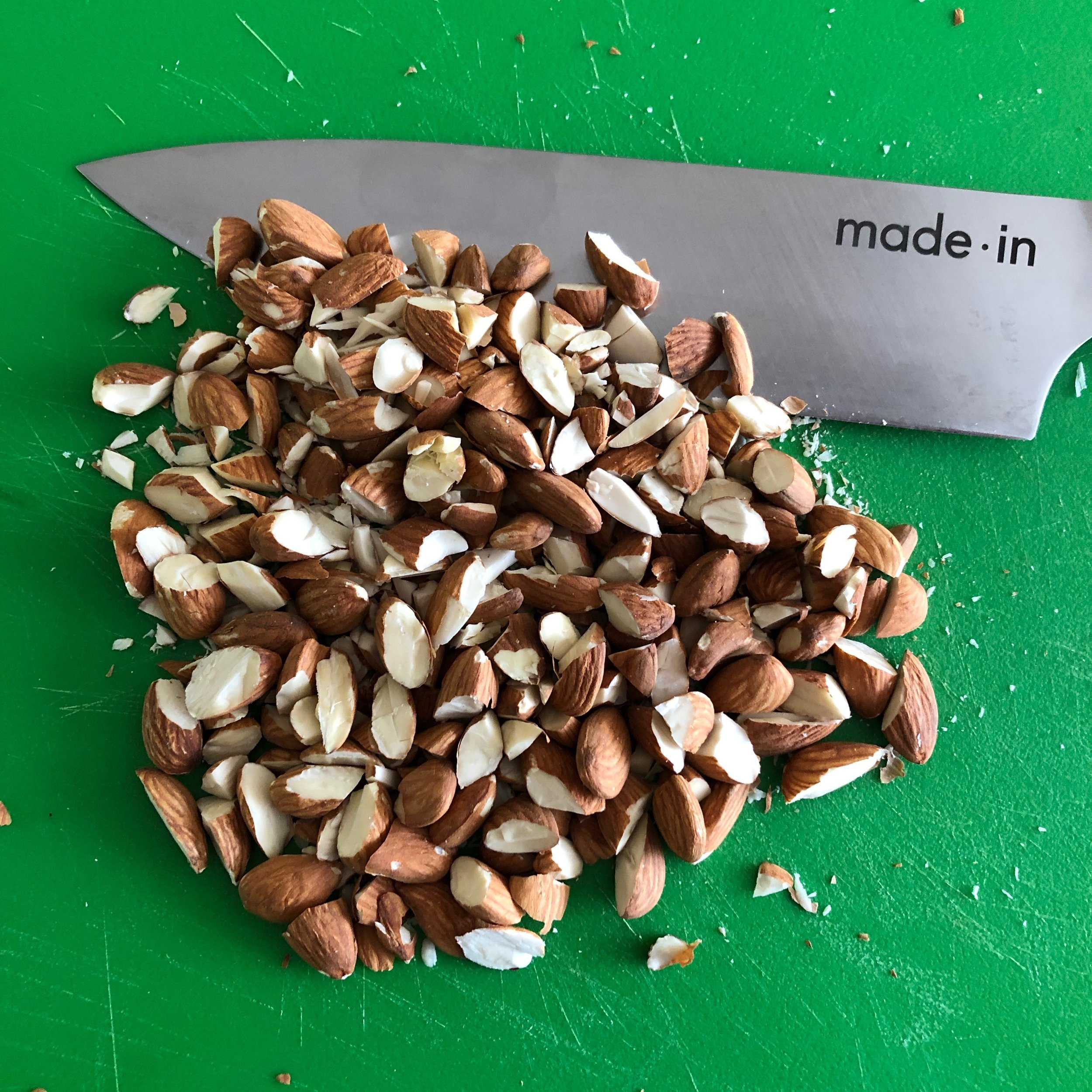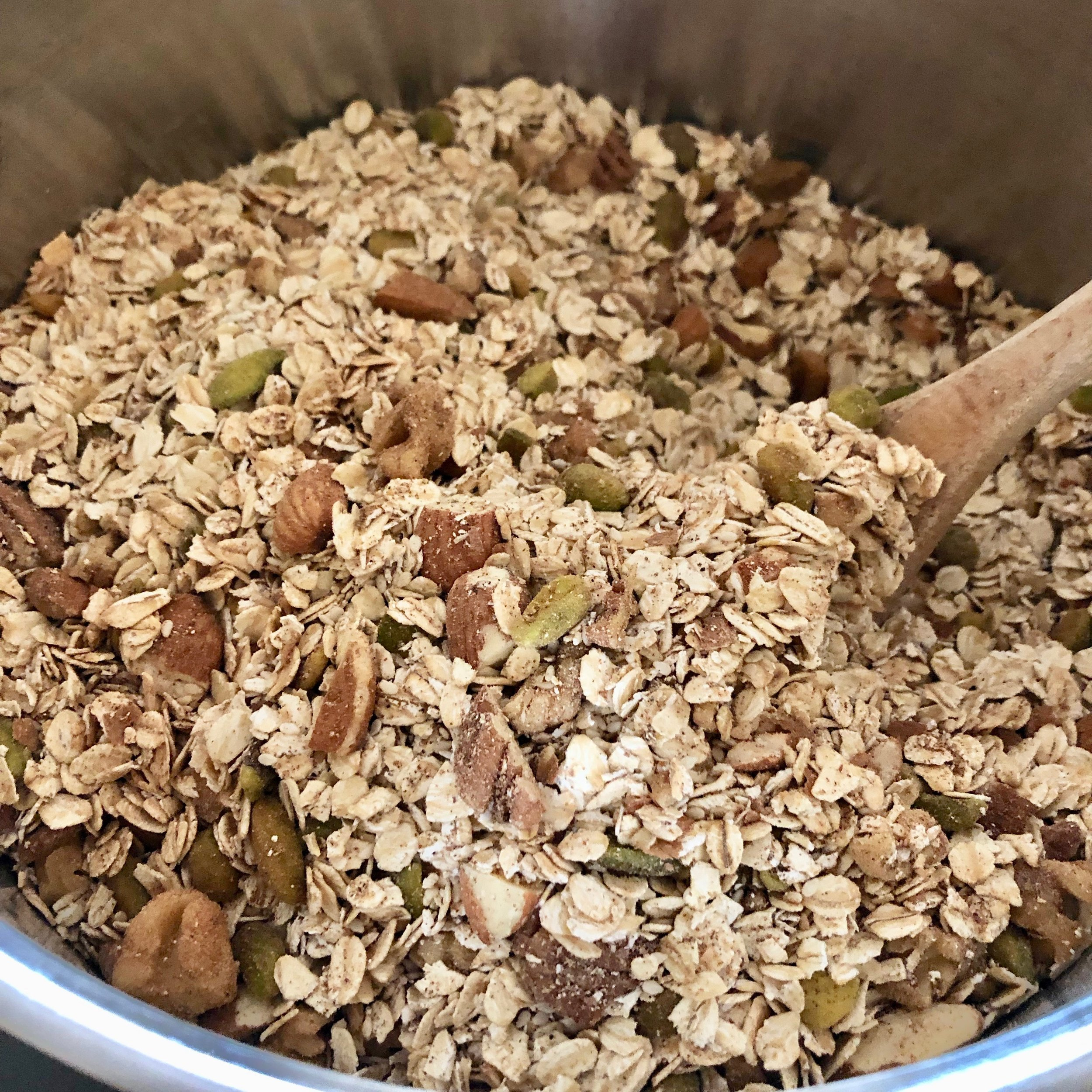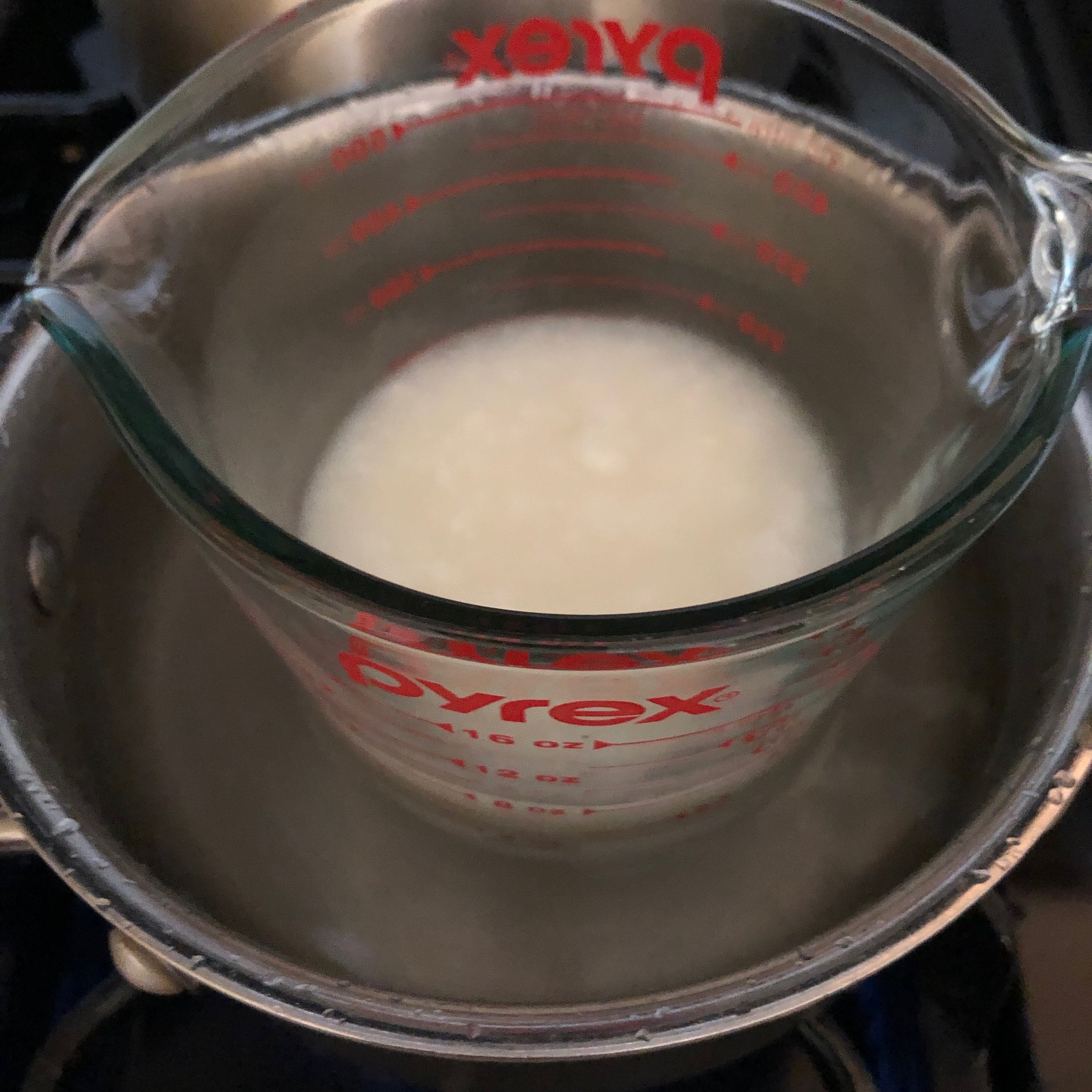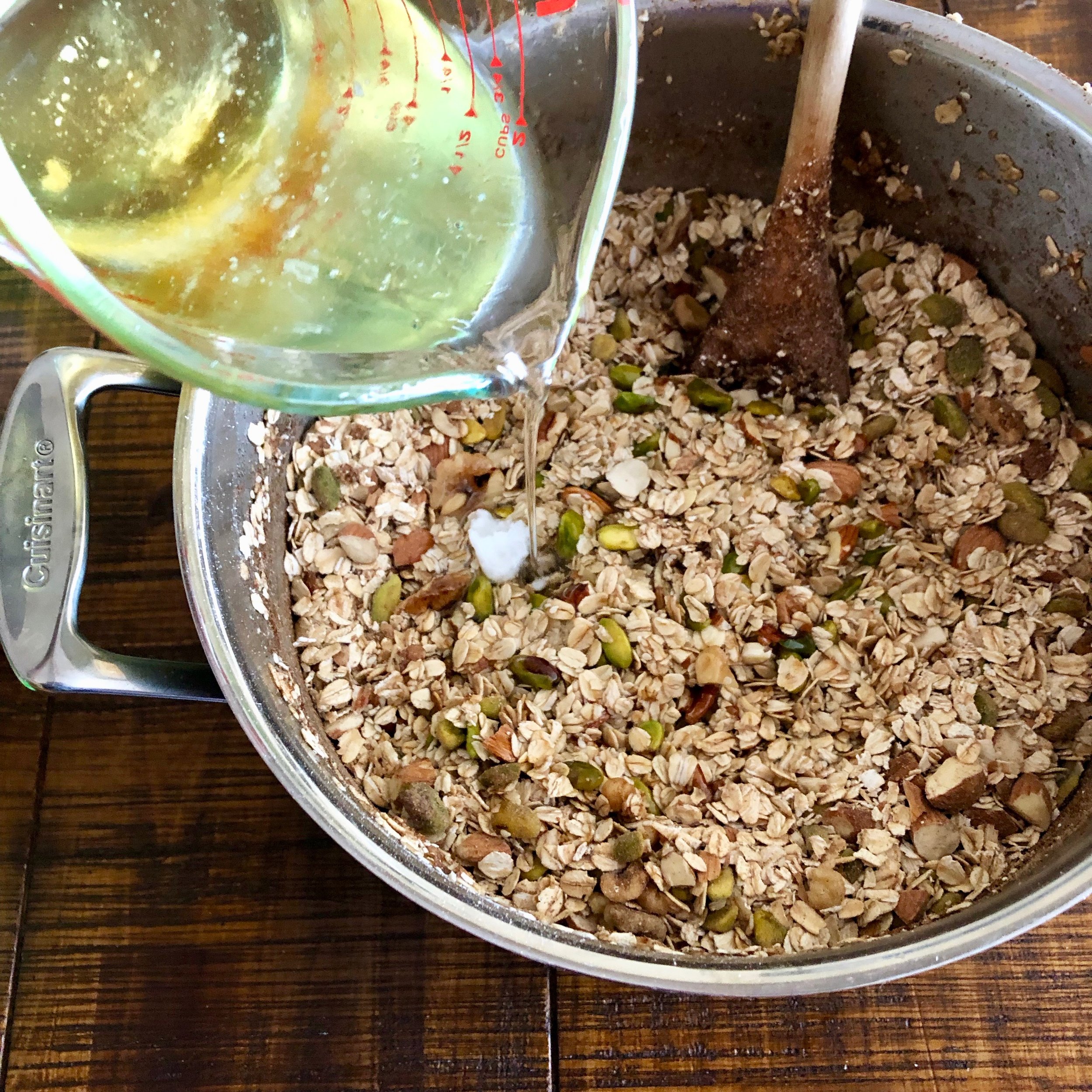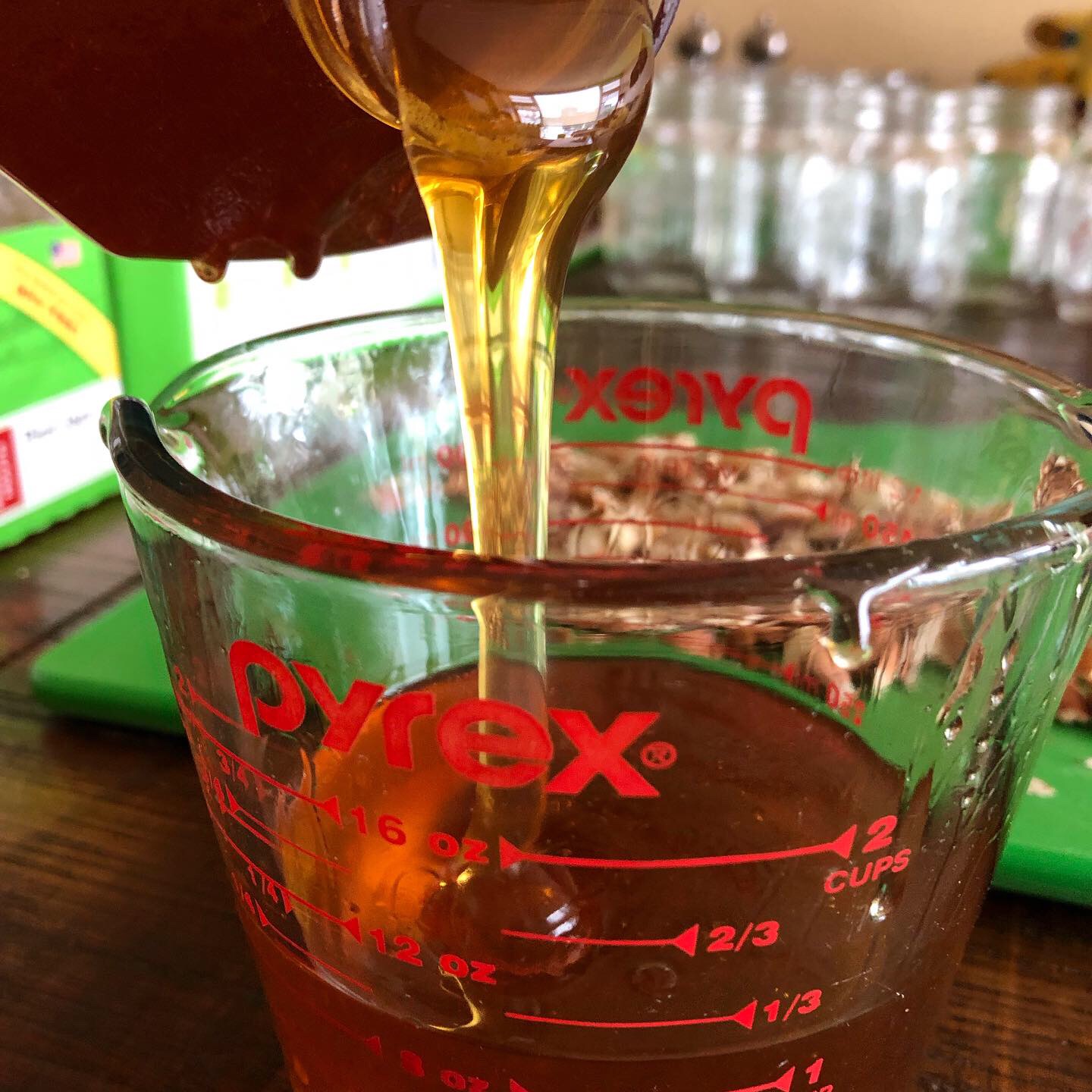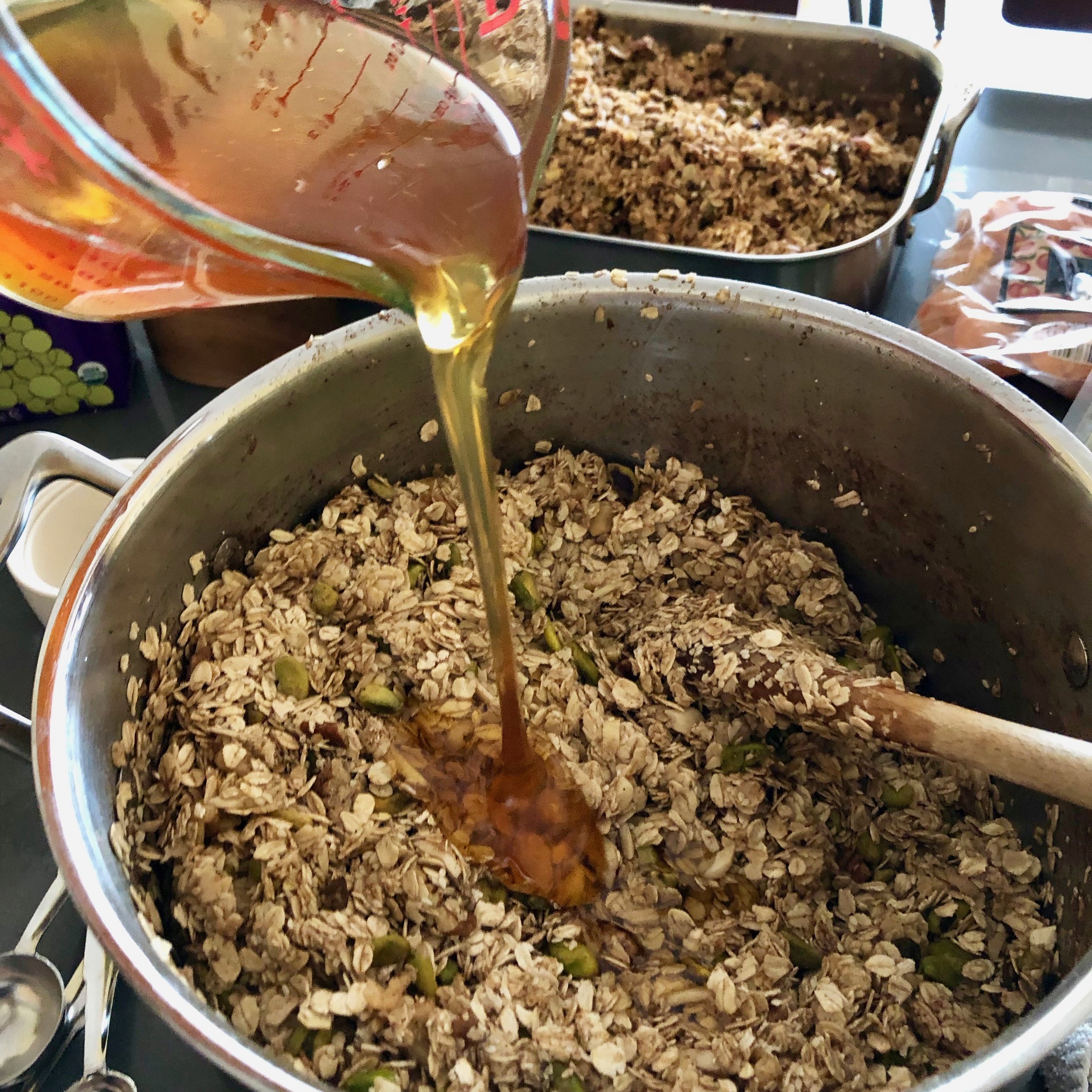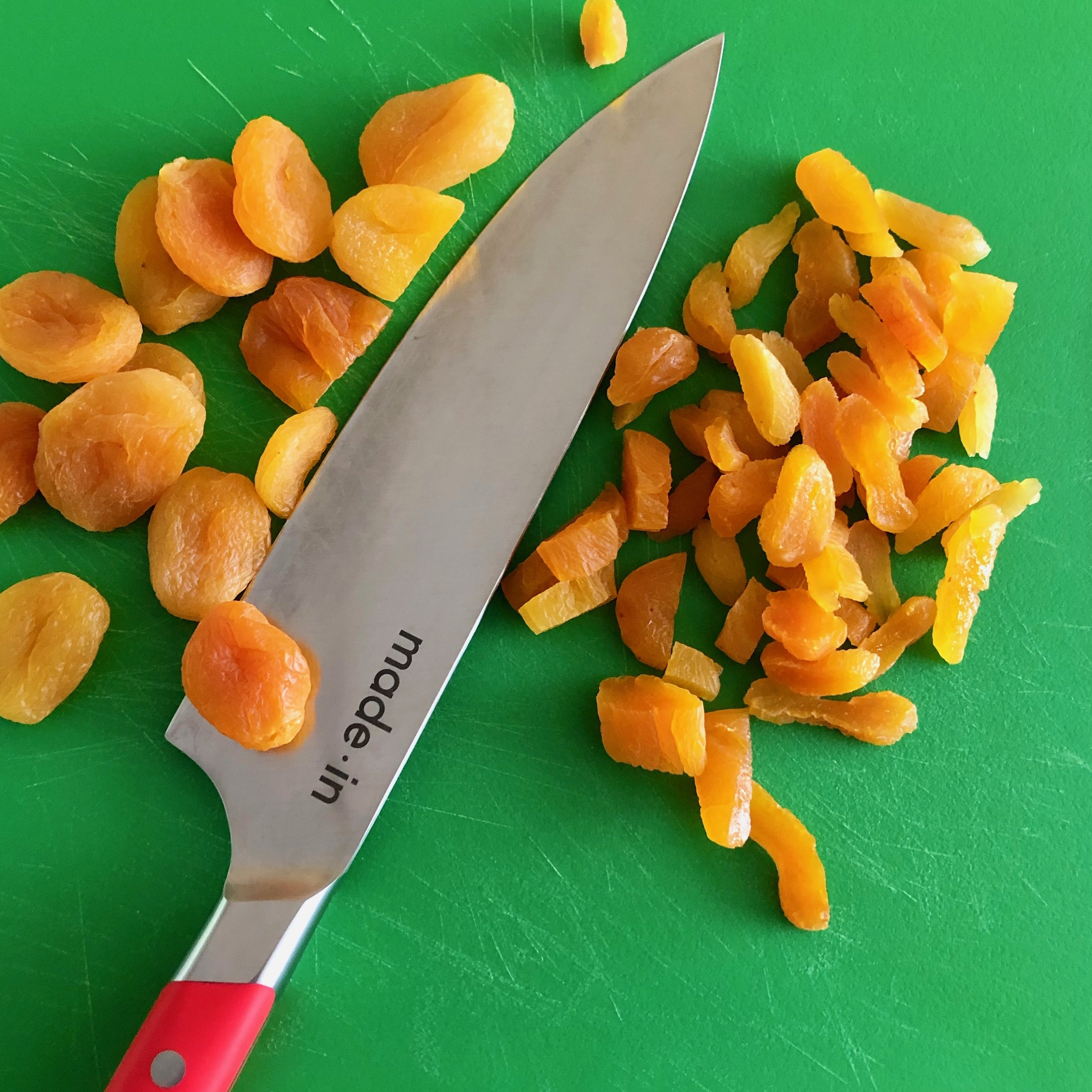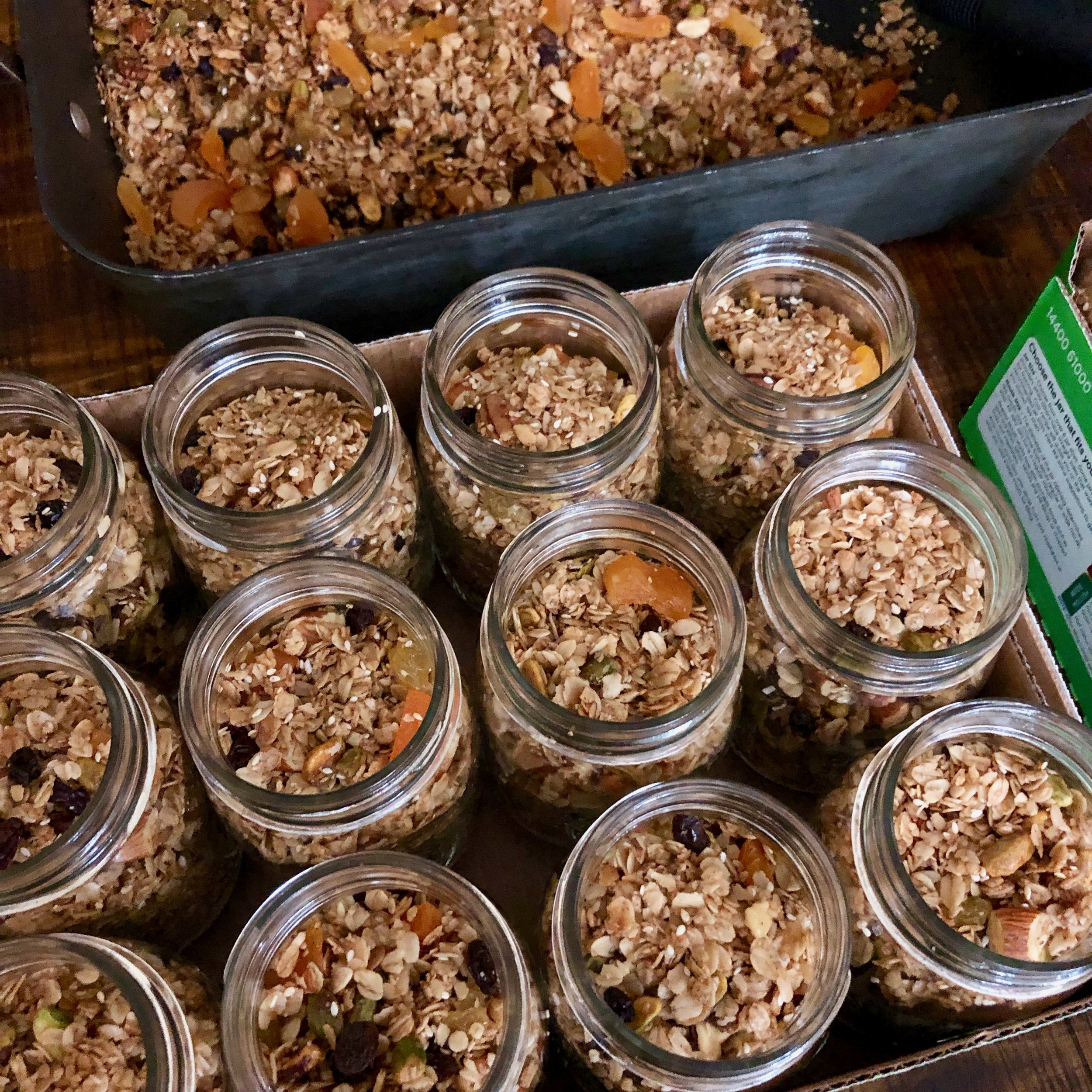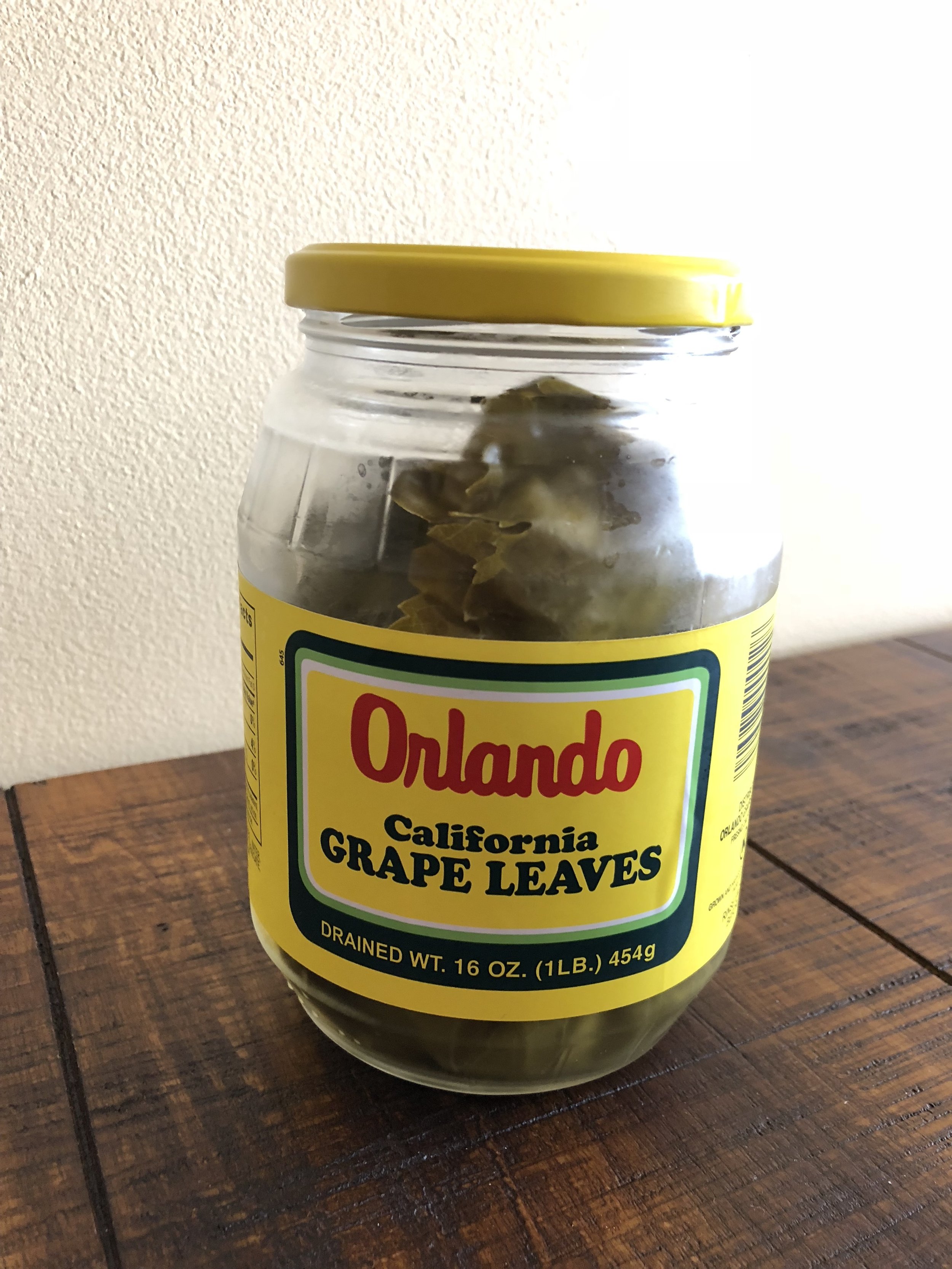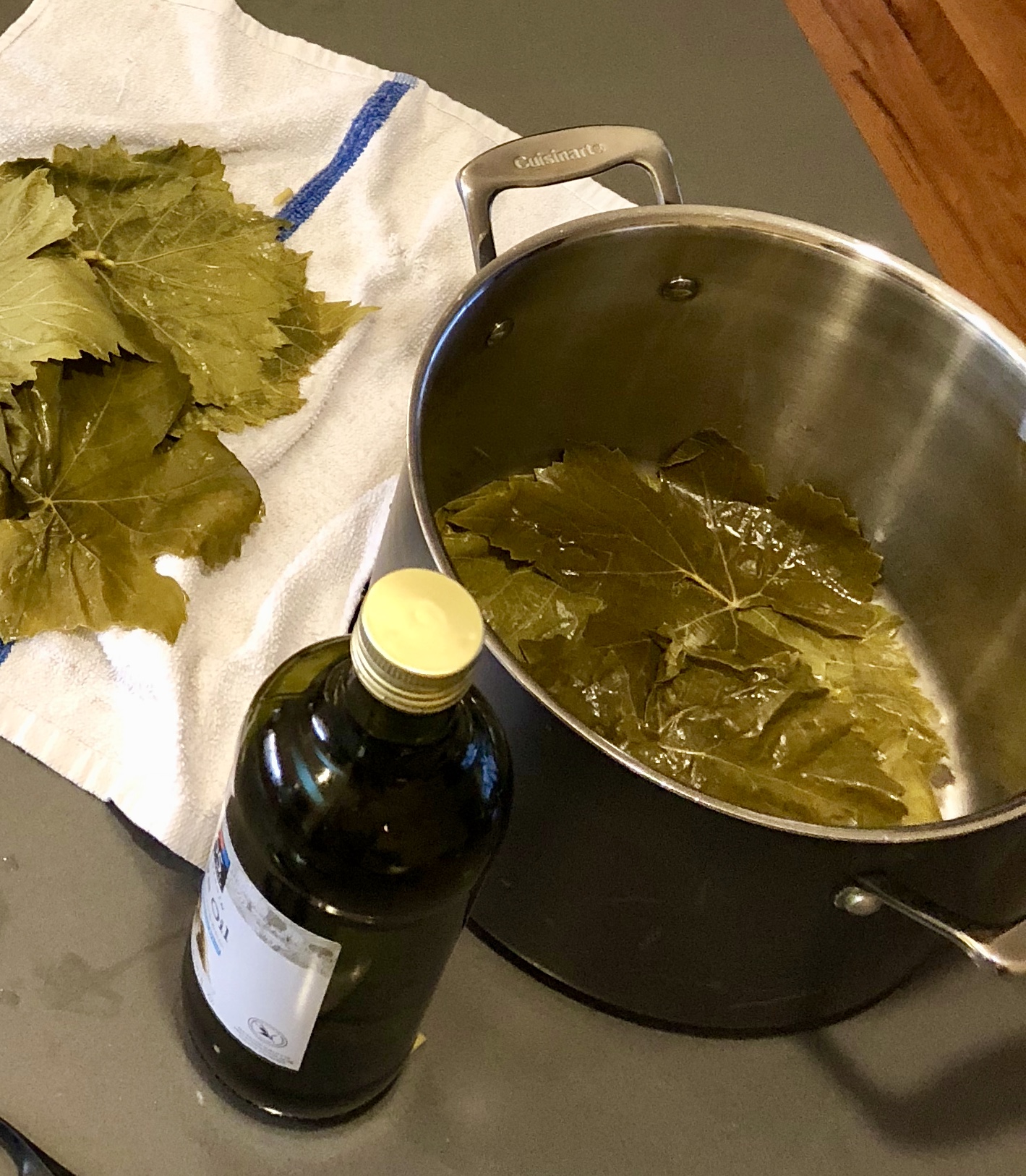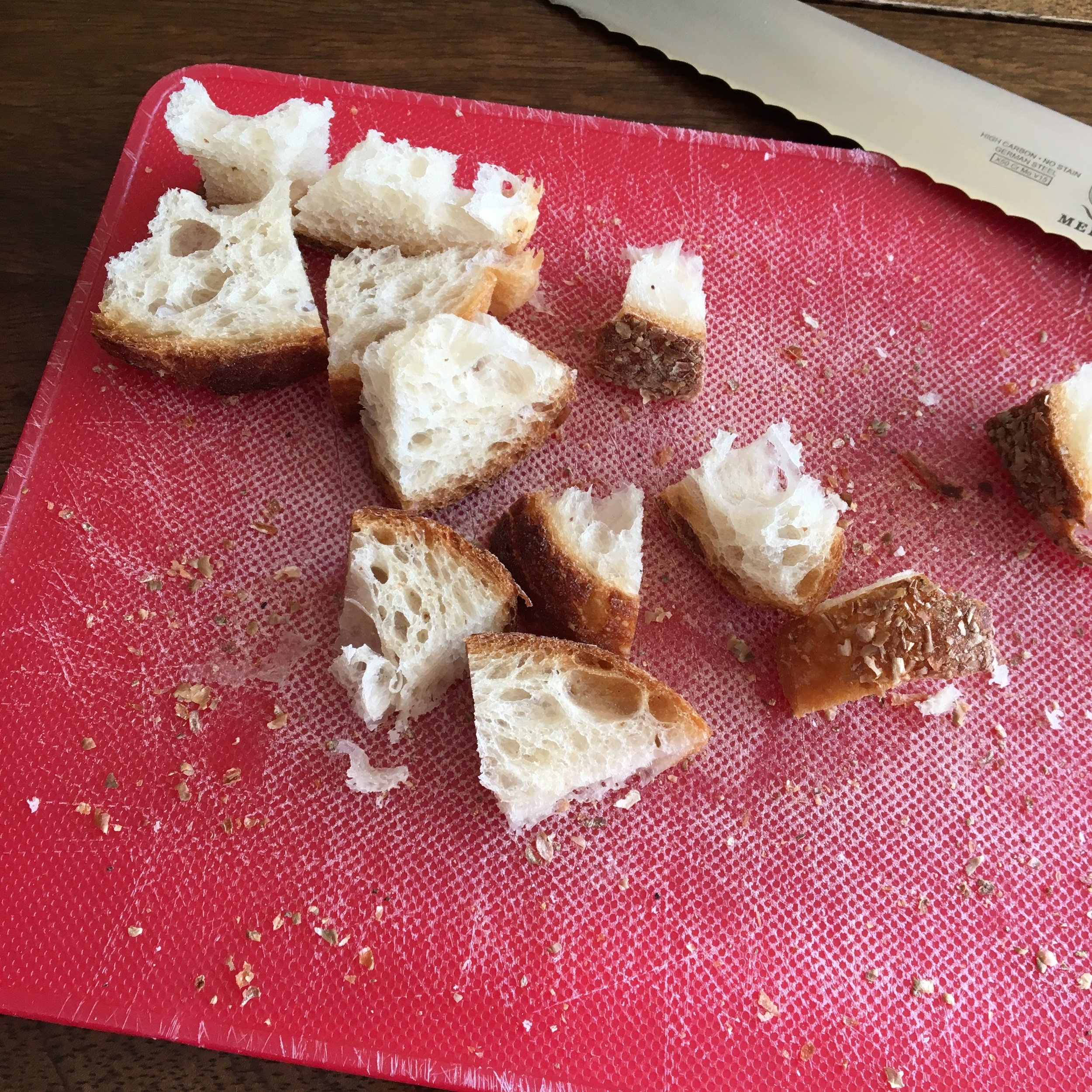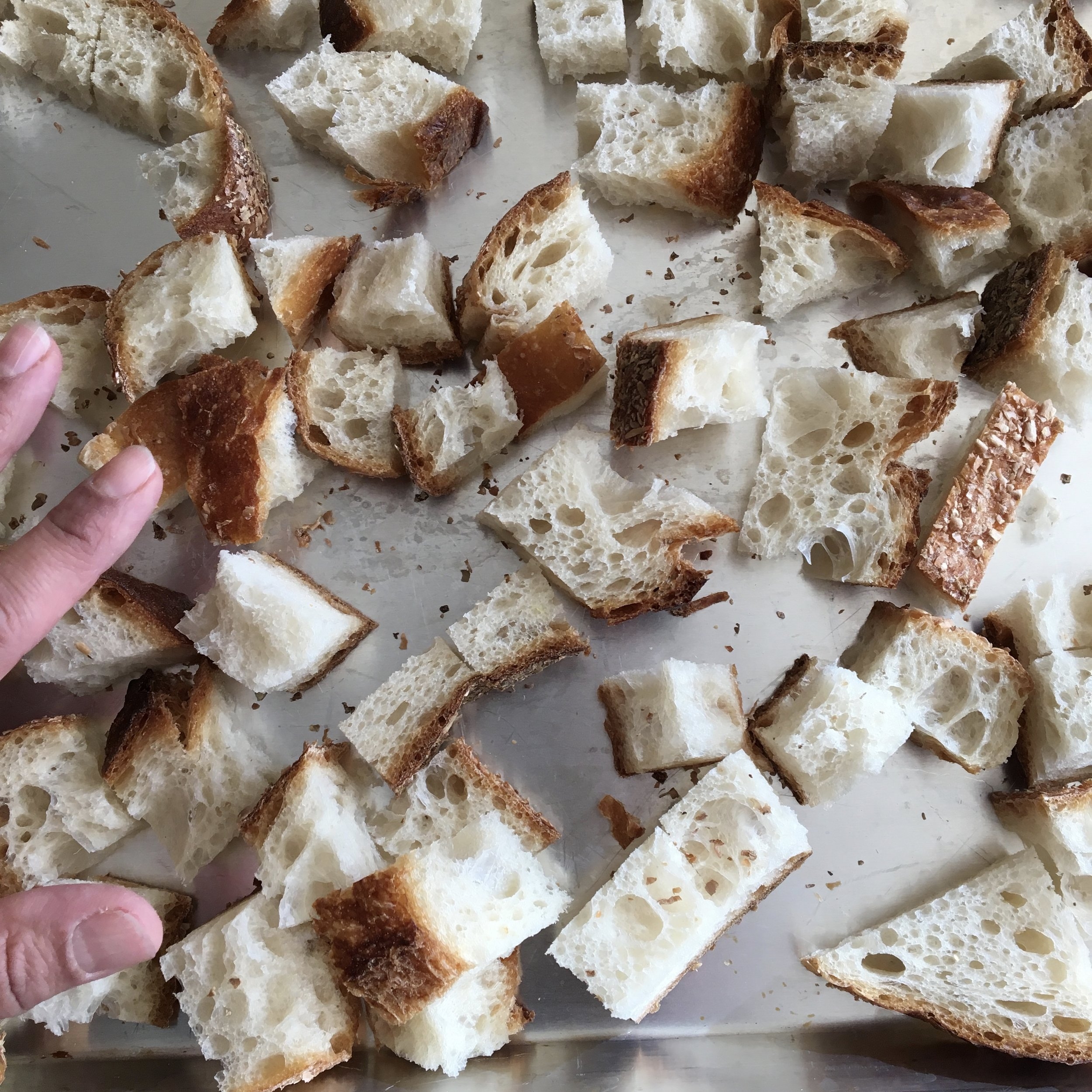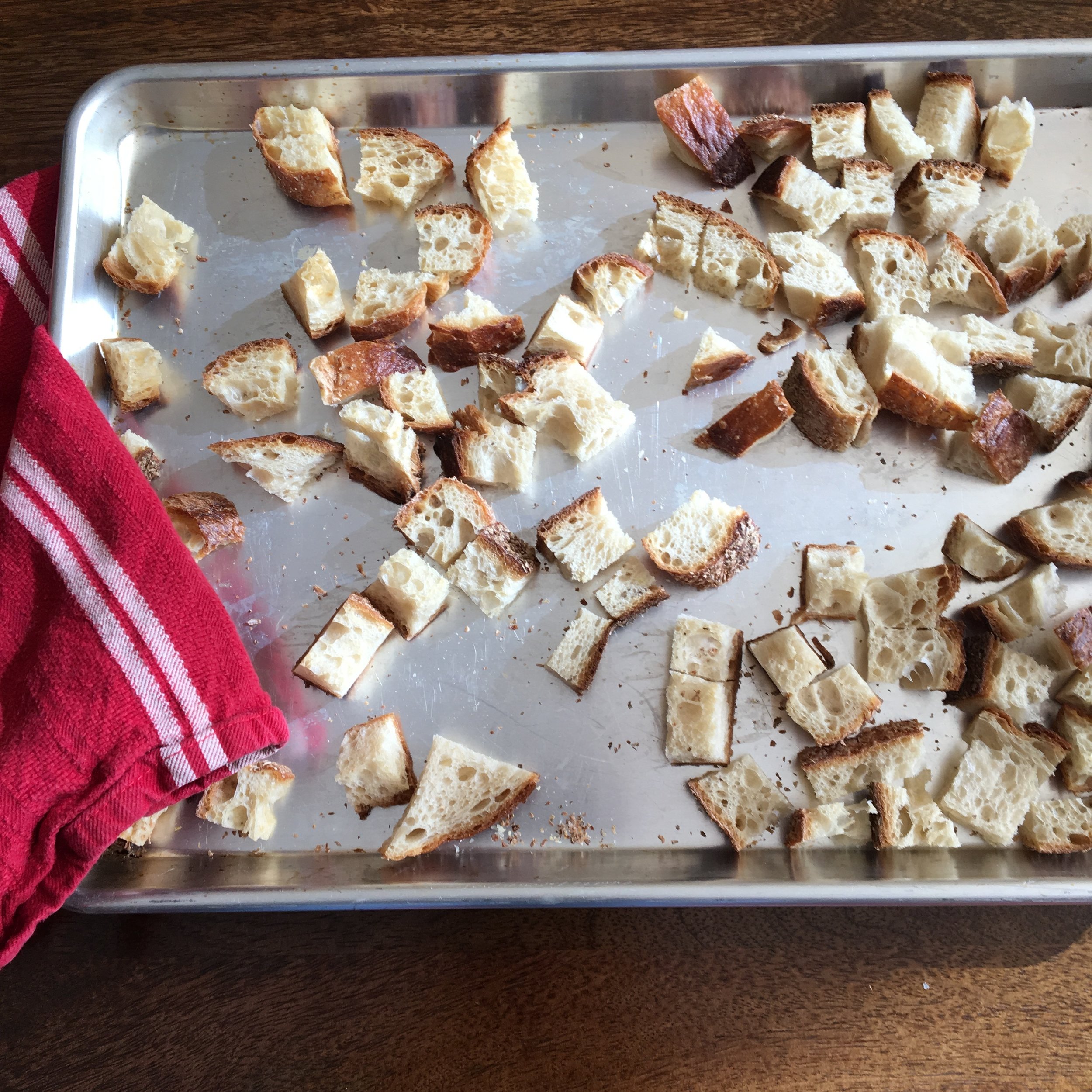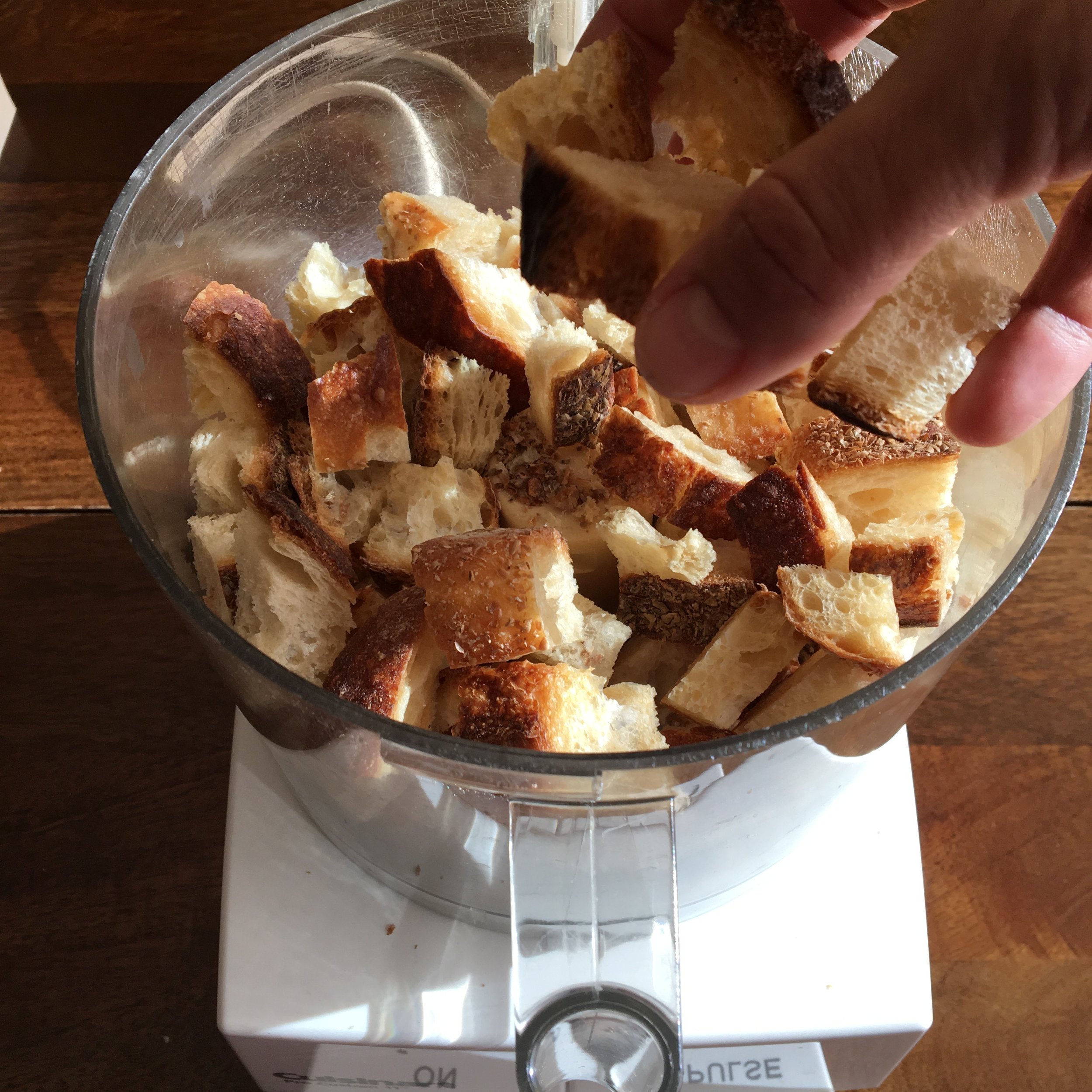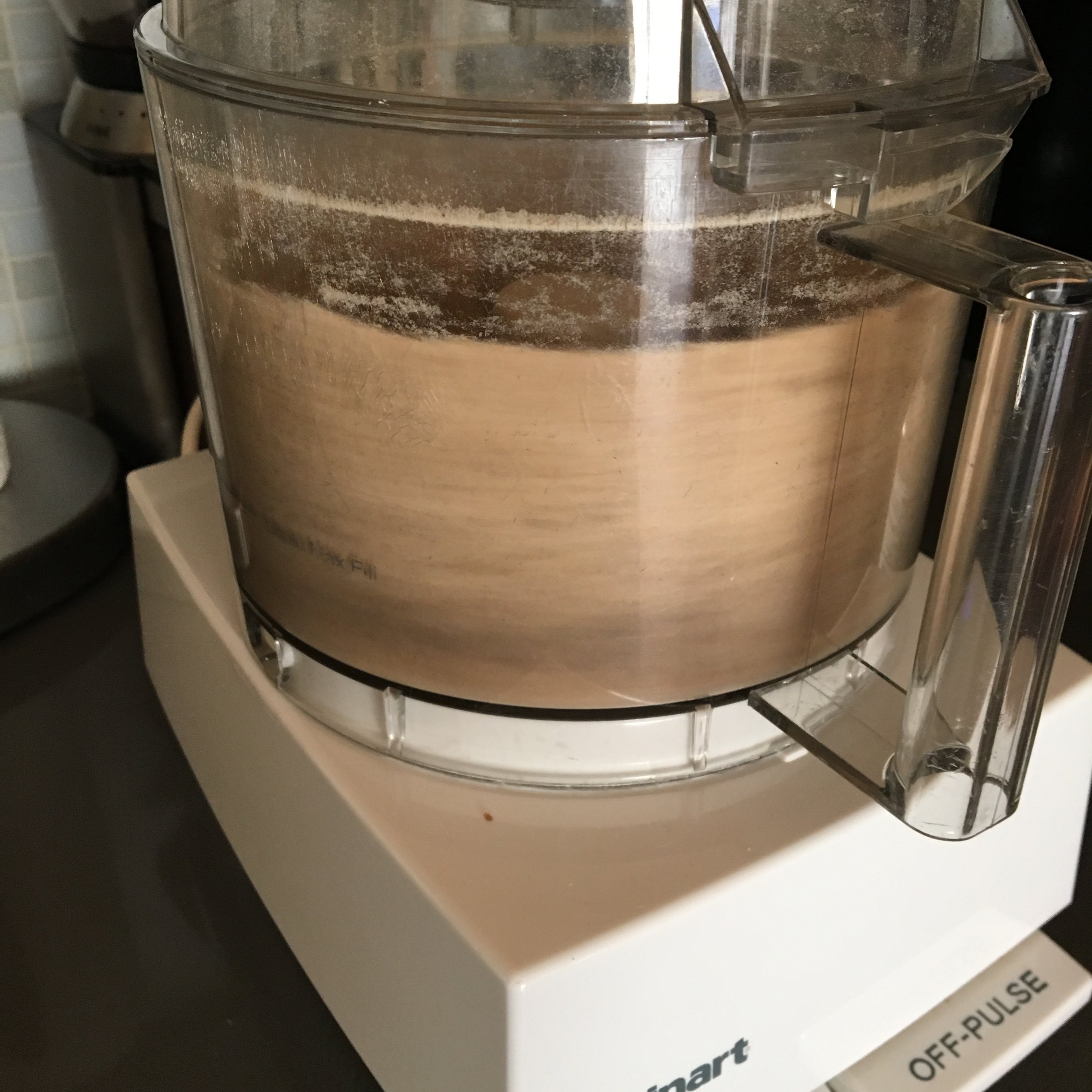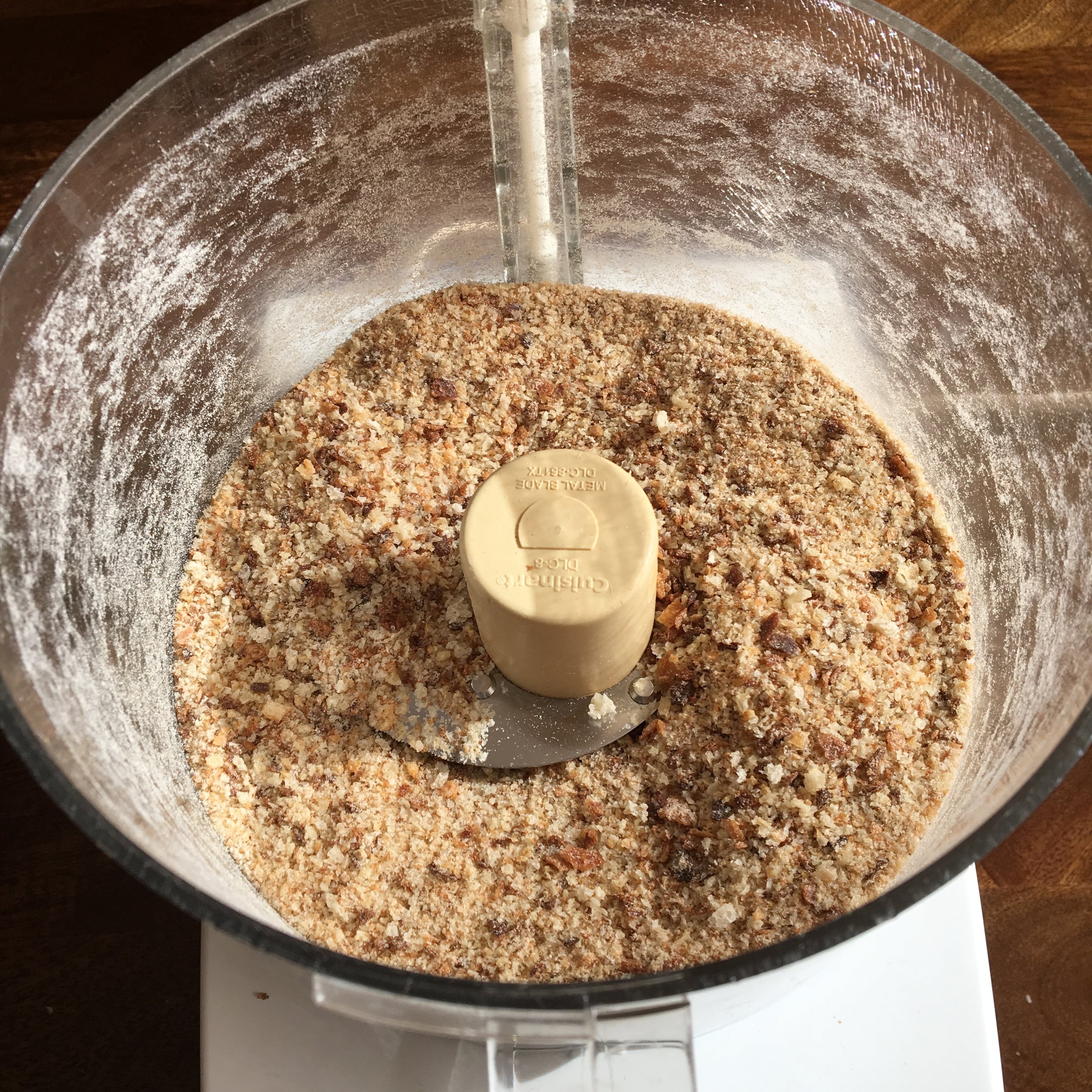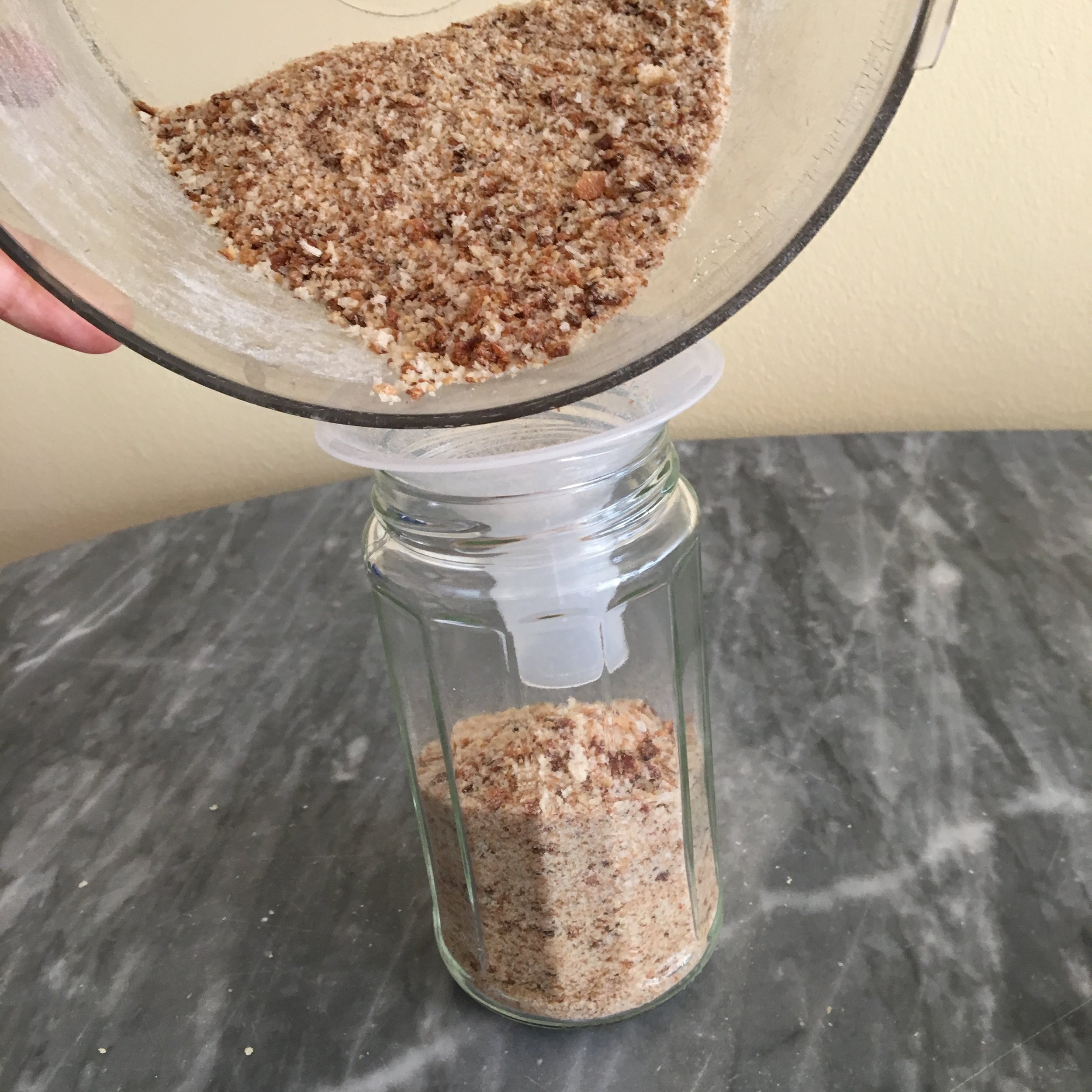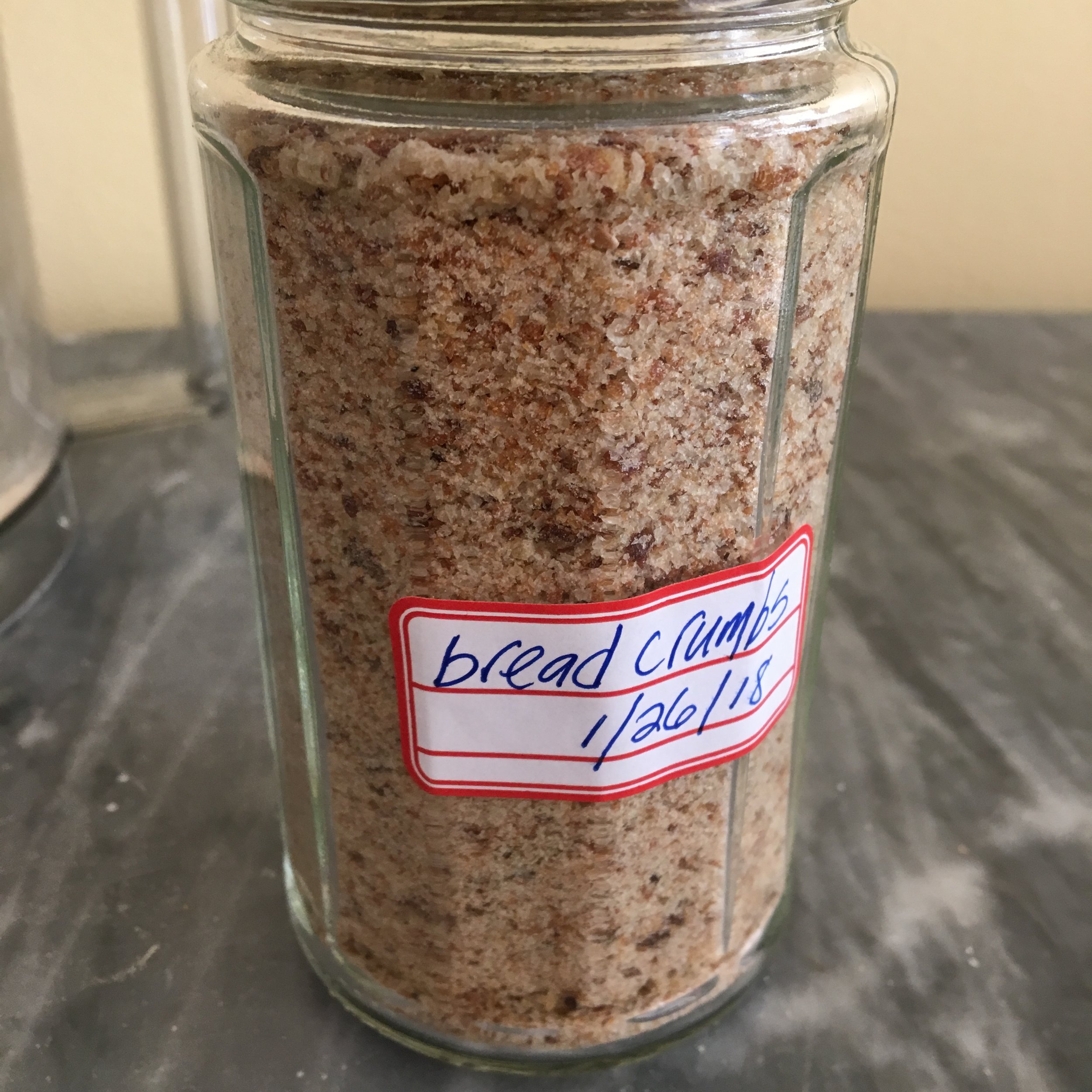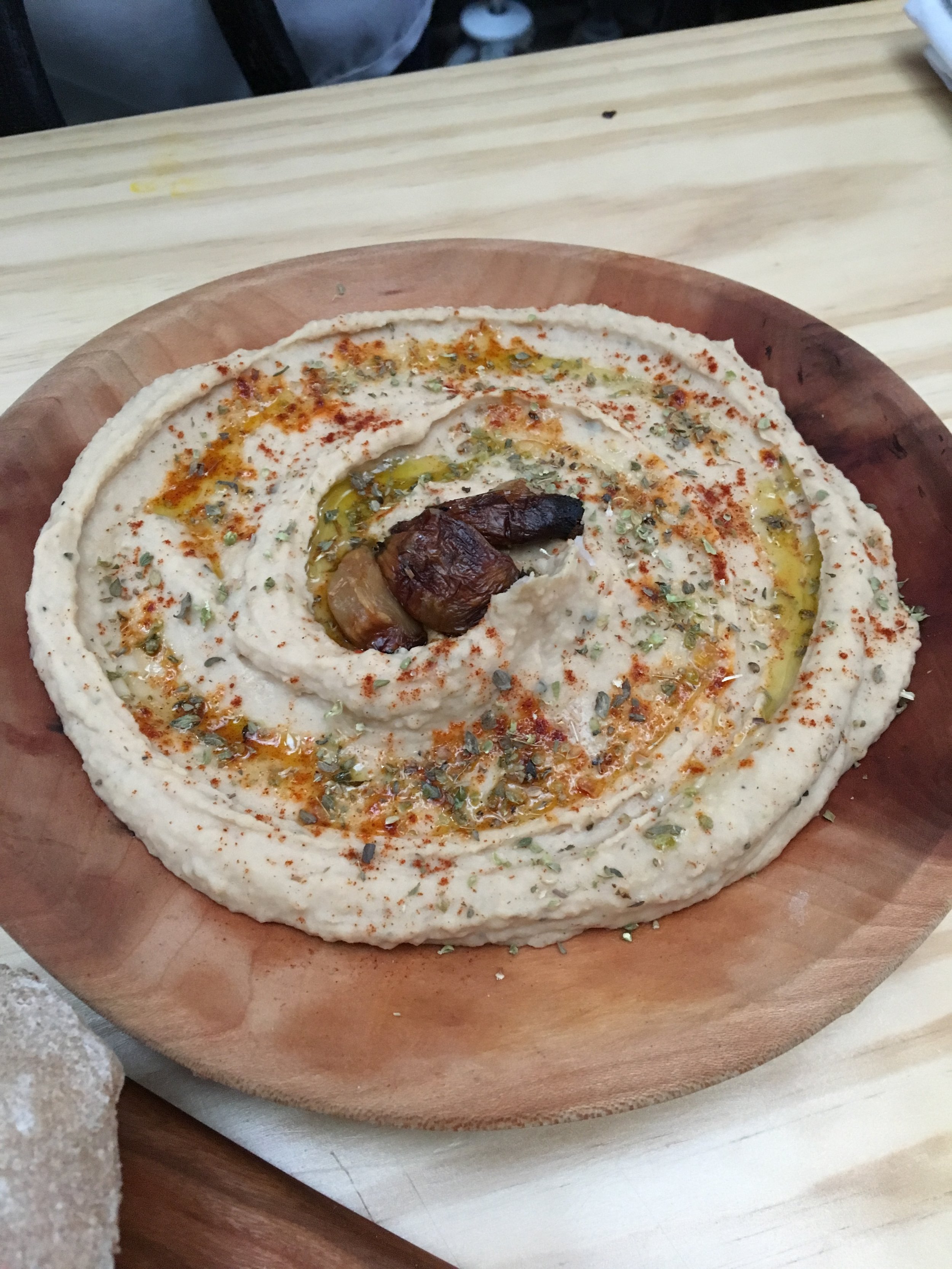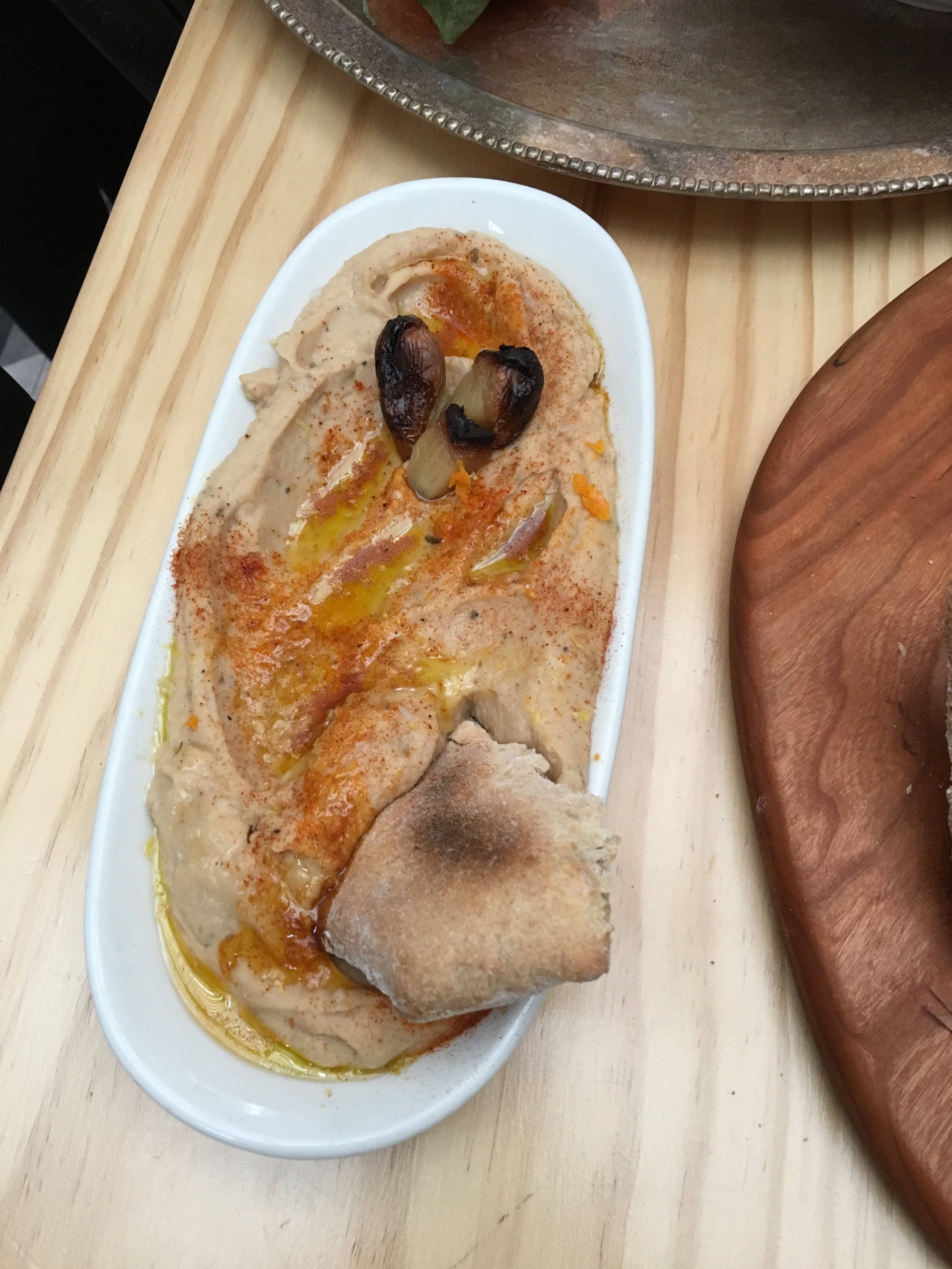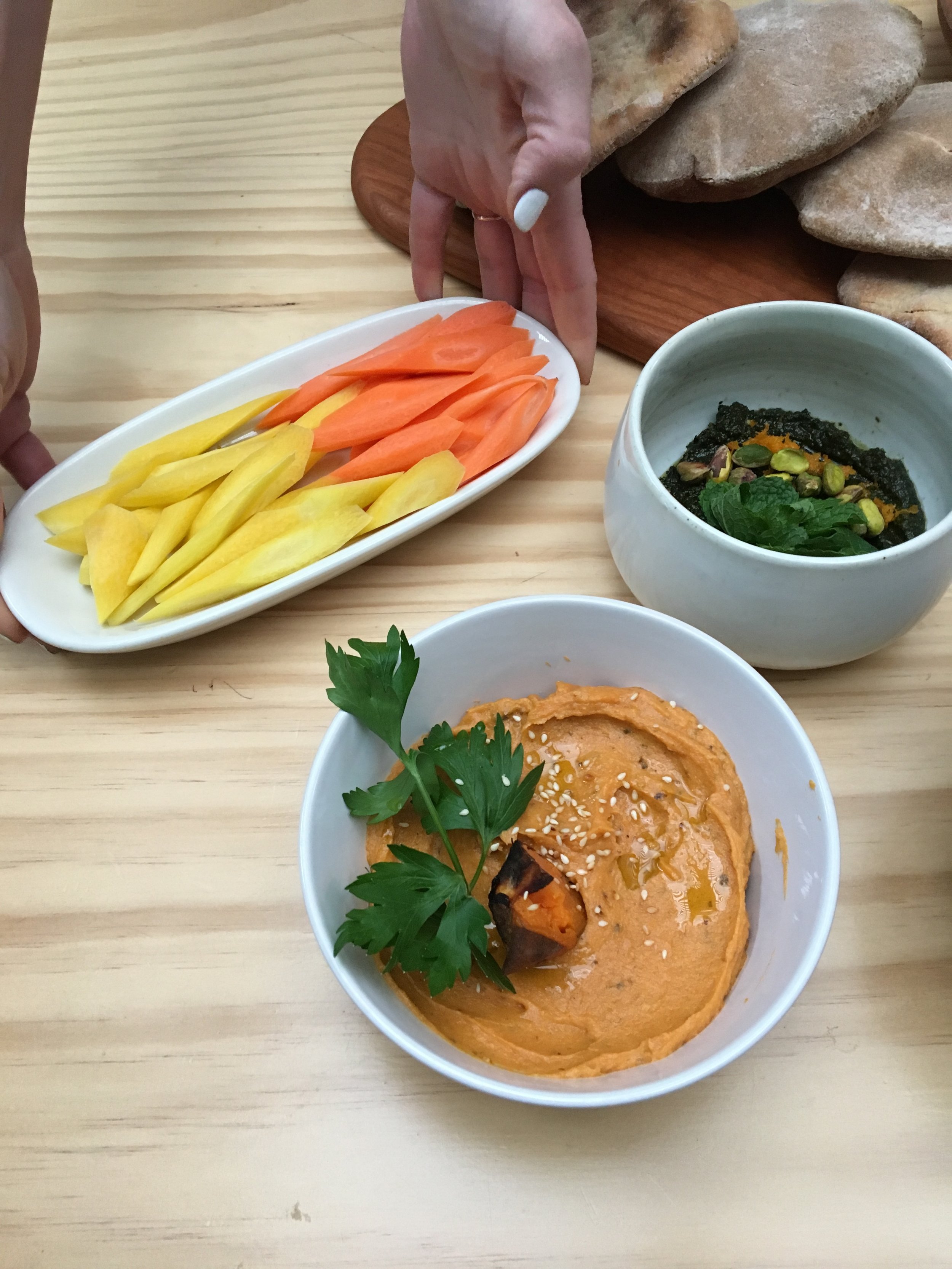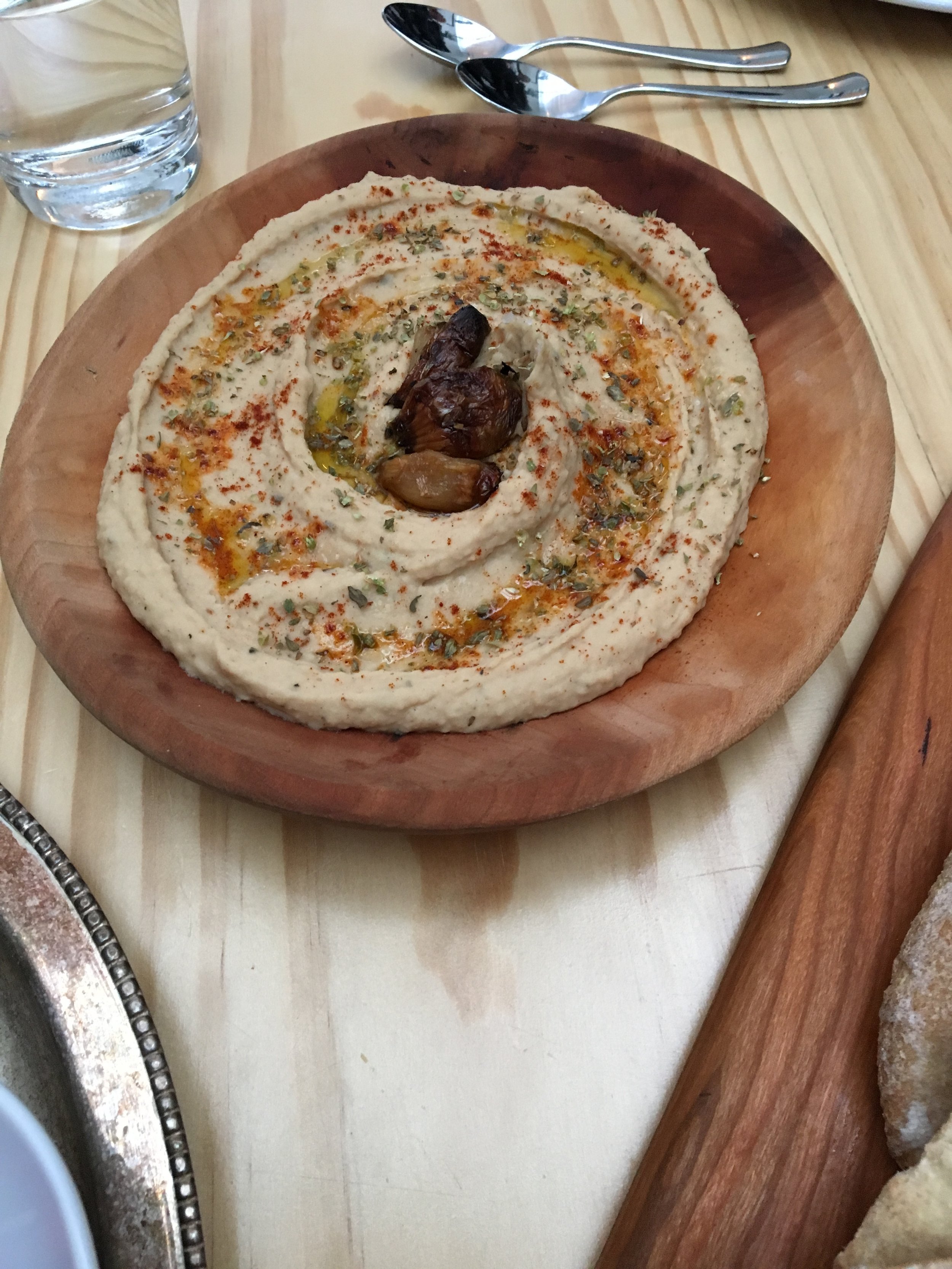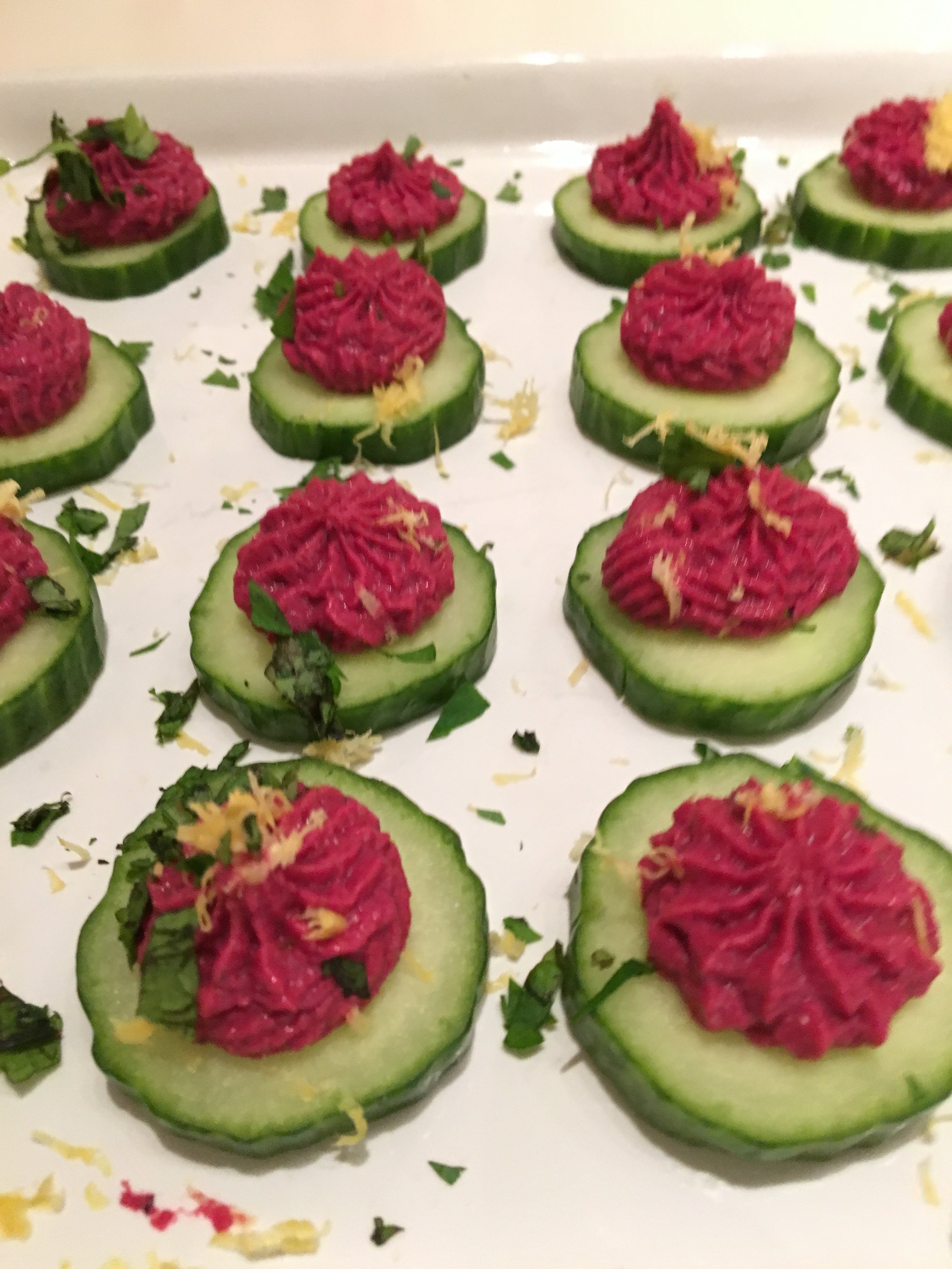This cranberry orange compote is everything I like about homemade cranberry sauce and the opposite of everything I dislike about canned cranberry jelly. It’s chunky so that you can actually recognize the star ingredient. It maintains the bright sourness of the cranberries and bitterness of the orange rind. It’s subtly sweet without being cloying. It's 100% worth making your own.
Pantry Clean-Out Granola
I’ve been baking my own granola for years now, usually inspired by the odds and ends I find when cleaning my pantry. It’s incredibly satisfying to empty the remnants of bags of nuts, a tub of dried mystery fruit, a jar of cinnamon, and a rubber-band wrapped package of quinoa in one fell swoop! In the process, I create a wide open pantry shelf AND breakfast of champions for weeks!
Armed with some photos I took during the recent production of 60 jars for a dear friend’s wedding, I’m finally putting this granola “recipe” on the Teaching Table blog.
As the air quotes suggest, this is barely a recipe but rather a set of suggestions and instructions for assembling goodness out of any combination of nuts & dried fruit, spice, seeds, oil & sweetener. Mix and match to create a personalized granola that suits your taste and needs (or uses what you find in the back of your pantry). You can even adjust the ratios of the dry ingredients. The amounts are relative — another vote for this solution to reduce food waste! Here’s a basic formula.
Tip: For an even crunchier granola, add 1 beaten egg white to the oats mixture.
Pantry Clean-Out granola
What you need:
Ingredients for Shannon & Dylan’s Signature (vaguely Morrocan) Granola.
2 ½ - 3 cups rolled (not instant nor steel cut) oats
½ - 1 cup whole grains such as quinoa, millet and amaranth
2 - 4 tablespoons seeds, such as sesame, chia and flax
1 - 2 teaspoons of ground spice, such as ginger, cinnamon, or cardamom, or powders like cocoa and matcha tea
½ - 1½ cups nuts, such as almonds, hazelnuts, walnuts, cashews and pistachios
½ cup oil (melted coconut, canola, hazelnut, pistachio, grapeseed, or olive oil)
⅓ cup sweetener in syrup form, such as honey, agave or maple syrup
½ cup dried fruit, such as raisins, tart cherries, apricots, figs, peaches or apples, ¼ inch dice
What you do:
Some of my favorite combinations:
All of these start with rolled oats…
walnuts + cinnamon + canola oil + maple syrup + dried apples
pistachios + almonds + cardamom + sesame seeds + coconut oil + honey + dried apricots
almonds + cocoa powder + nut oil (hazelnut, walnut) + agave + dried cherries
cashews + ginger + quinoa + coconut oil + agave + coconut flakes + dried mango
matcha tea powder + cashews + coconut oil + agave + golden raisins
walnuts + pistachios + cinnamon + quinoa + grapeseed oil + honey + raisins
What goes into your favorite mixture?
Vegetarian Dolmas: Grape Leaves Stuffed with Spiced Lentils and Rice
Wrapped and rolled foods are the ultimate kids-in-the-kitchen activity. After preparing all of the components, allow kids to help combine the filling. Then enlist their support to do all of the wrapping and rolling. After a brief demonstration, some coaching and practice, you can probably even walk away and allow your little one to complete the job. Share this instructional video provided by 6-year-old Emory with your child.
Vegetarian Dolmas: Grape Leaves Stuffed with Spiced Lentils and Rice
Dolmas or stuffed grape leaves are often made with a combination of gently spiced ground lamb and rice. We make a savory and satisfying plant-based version using french lentils. I also choose brown basmati rice for additional fiber, nutrients and texture. Omit the honey entirely or substitute agave nectar to make this recipe suitable for vegans.
Yield: approximately 3 dozen
I generally use jarred grape leaves. They work just fine but, of course, if you are on the west coast or are fortunate enough to have access to fresh grape leaves when they are in season, use them. Just soak fresh leaves in hot water while you prepare the filling.
What you need:
Grape leaves:
½ pound fresh grape leaves, soaked in hot water or 1 pound jar preserved grape leaves, rinsed and drained well, picked through with broken or ripped leaves reserved for lining the bottom of the pot
Rice:
2 quarts water
1 cinnamon stick
½ cup long grain brown rice
¼ teaspoon salt
½ cup mint leaves, minced
2-4 scallions, minced
⅓ cup pine nuts, chopped
⅓ cup currants or raisins
Line the bottom of the stock pot with grape leaves to prevent your dolmas from burning or browning. Use the broken or torn leaves.
Lentils:
2 tablespoons extra virgin olive oil
1 small onion, small dice
2 cloves garlic, minced
1 ¾ cup cooked lentils (dark brown, green, or beluga)
1 teaspoon nutmeg
½ teaspoon cinnamon
1 teaspoon cumin seeds
1 teaspoon dried oregano
½ teaspoon allspice
1 tablespoon dried mint (or one mint tea packet)
Simmering Liquid:
¼ cup lemon juice
½ cup olive oil
2 teaspoons honey (omit or agave for vegan)
1 cup water or vegetable broth
½ teaspoon salt
freshly ground black pepper
Roll tightly, but gently, so as not to tear the leaves, pushing in the sides as you go. Walk away, and let the kids do all the rolling while you do the dishes...or take a nap.
What you do:
Bring 2 quarts (8 cups) water to a boil. Add cinnamon stick, rice and ¼ teaspoon salt. Reduce to a rolling boil and cook 20 minutes or until just tender. Drain and rinse in cold water.
Combine cooked rice with fresh mint, scallions, pine nuts, and currants.
Heat olive oil in a large sauté pan over medium high heat. When it shimmers, add onion and a pinch of salt. When onion is soft, add garlic and sauté 1 minute. Add lentils, nutmeg, cinnamon, cumin, oregano, allspice, and dried mint/tea. Combine with rice mixture. Allow to cool slightly.
Set aside the 36 best leaves for stuffing. Line the bottom of a heavy stock pot with the remaining leaves. Stuff each with about 1 to 2 teaspoons of rice/lentil mixture. Place leaf smooth side down, with stem close to you. Trim long or thick stems. Fold stem end over rice and hold in place. Fold in sides and roll away from you. Use any broken leaves for lining the bottom of the pot. Arrange dolmas (stuffed leaves) snugly in the pot, in layers if needed.
In a medium bowl, whisk together the lemon juice, olive oil, honey or agave, water or stock, salt and pepper. Pour this mixture over the leaves, cover with a plate to hold dolmas down.
Cover, bring to a simmer, and cook 1 1/2 hours, basting occasionally.
Note: Use the "pasta method" for cooking the rice used in dolmas. Rather than steaming rice with an exact ratio of water, you will boil the rice in a large pot of salted water until al denté and then drain. You could certainly use leftover rice that was made using the standard rice cooking method but the texture may be slightly mushy in the grape leaves.
Tip 1: The simmering liquid makes a delicious soup or broth after the dolmas are done simmering in it. Use it to store dolmas in the fridge up to one week, drink it or serve as soup!
Tip 2: When I don't have fresh mint available, I just increase the amount of dried mint used. Just add all of the dried mint together to the lentil mixture to sauté before adding to the rice. I've also successfully substituted chives for the scallions in a pinch.
All Hail the Stale
Make your own Breadcrumbs
When life gives you stale bread, you take that brick and turn it into breadcrumbs. Did you know that a canister of store-bought breadcrumbs contains approximately 40 different ingredients, many unpronounceable? And those sawdust particles are rarely ever made from whole grains. Compare that to just 5 or 6 ingredients found in breadcrumbs made from a loaf of your favorite local bakery or home-baked bread. Why? It's all about the shelf life - how long can that canister sit in a warehouse, 18-wheeler, grocery store, and your pantry? With those ingredients, likely through the next nuclear winter. You don't need that, though. Do you?
So make your own. They won't survive nuclear winter, but they will last at least a month or more in an airtight glass jar. It's so simple and you will feel so satisfied knowing you spared a dried out loaf from the garbage chute and now have a wholesome ingredient on hand. And your friends might refer to you as Martha Stewart. Wait, don't let that be the reason you don't try this at home. Please try this at home.
How to use them:
There are so many uses for homemade breadcrumbs. Here's just a few. Please share yours and I'll add to this list.
veggie burgers (black bean, lentil walnut, kasha potato, the list goes on and on)
stuffed mushrooms
breading or coating for croquettes
meatballs of all varieties (note that if you are mimicking the "Italian style" breadcrumbs used in classic meatballs, you will want to add a little dried parsley, oregano, basil and a pinch or two of salt)
crunchy topping for a casserole like my pasta, cauliflower and cheese bake (recipe coming soon) or my vegan green been casserole
to add texture to a salad or grain bowl
as an alternative to croutons in caesar salad or this roasted romanesco with lemony anchovy dressing
2 notes for the gluten free crowd:
1. The above procedure might be a lifesaver for you. Now you can make your own gluten free bread crumbs with your favorite gluten free bread or crackers and save yourself the trouble and expense of finding rare packaged gluten free breadcrumbs.
2. There are gluten free substitutes for the uses of breadcrumbs I listed here. Stay tuned for some recipes and techniques coming soon. First up: my gluten free alteration of a family classic stuffed mushroom recipe.
What you do:
Variations on Hummus
Stop rolling up to the school potluck with a store-bought tub of ordinary hummus and some crunchy carbs for dipping. Hummus is simple to make from scratch. And it does not need to be boring. You can add spices, change up the acid and even hide some vegetables in it. Here's a straightforward formula followed by various modern spins, including a colorful roasted beet hummus you can spread on your kids' sandwiches. My sweet potato black bean variation below is exactly what your Superbowl party ordered. Bonus: these spreads make great baby food too, especially to pack a smooth high protein punch for a little peanut like mine who needs to pack on some pounds.
Basic Hummus Formula
Makes about 1½ cups
What you need:
1-2 cloves of garlic
1 1/2 - 2 cups cooked legumes (chickpeas, black beans, white beans, lentils, etc.)
1-3 Tablespoons tahini
1/4 cup oil (olive, canola, avocado, etc.)
1-2 Tablespoons acid (lemon juice, lime juice, apple cider vinegar, etc.)
salt & pepper to taste
1/2 - 1 cup cooked vegetables (optional)
1-3 teaspoons ground toasted spices (optional)
What you do:
Simply put all ingredients (except the acid, spices and salt) into a food processor and purée until smooth. Taste and add acid, spices, and salt gradually to get desired texture and taste. You can always add more salt, acid and liquid but it is difficult to take it away or add more of all of the other ingredients if you go overboard on, say, the lemon juice and cayenne. If your spread is too thick, add more acid (lemon juice, vinegar, etc.) or plain old H2O if you want to thin it without altering the taste too much.
Note on beans: When using canned beans, I drain them and rinse off the liquid first to get rid of any extra salt or any taste imparted by the canning process. You can also easily cook your own beans. More on that in a future post.
Try these variations:
Add a roasted beet and toasted ground cumin, cinnamon and cloves. You could also follow my recipe for Roasted Beet Hummus.
Substitute a sweet potato for the beet and roast without foil. Use cumin, cayenne, dried ground chipotle and/or smoked paprika for the spices. Substitute black beans or stick with the chickpeas.
Instead of beet or sweet potato, use ½ cup of any cooked vegetable (skins removed, roasted, grilled, or steamed), such as broccoli, red bell peppers, carrots, or squash.
Add ½ cup of prepared pesto and decrease the olive oil to 2 tablespoons.
Use lime juice, apple cider vinegar, sherry vinegar or white wine vinegar in place of the lemon juice.
Add an entire head of garlic roasted in olive oil. Decrease the olive oil to 2 tablespoons. Use chickpeas or substitute navy or cannellini beans.

